Desert landscaping offers an extraordinary opportunity to create stunning outdoor spaces that celebrate natural beauty while conserving water and requiring minimal maintenance. These carefully curated landscape ideas embrace the harsh elegance of arid environments, transforming challenging conditions into design advantages. From dramatic cacti gardens to serene meditation spaces, desert landscapes blend functionality with breathtaking aesthetics. Whether you're working with a small urban courtyard or expansive property, these design concepts utilize drought-tolerant plants, innovative hardscaping, and strategic water features to create remarkable outdoor living environments that thrive in dry climates year-round.
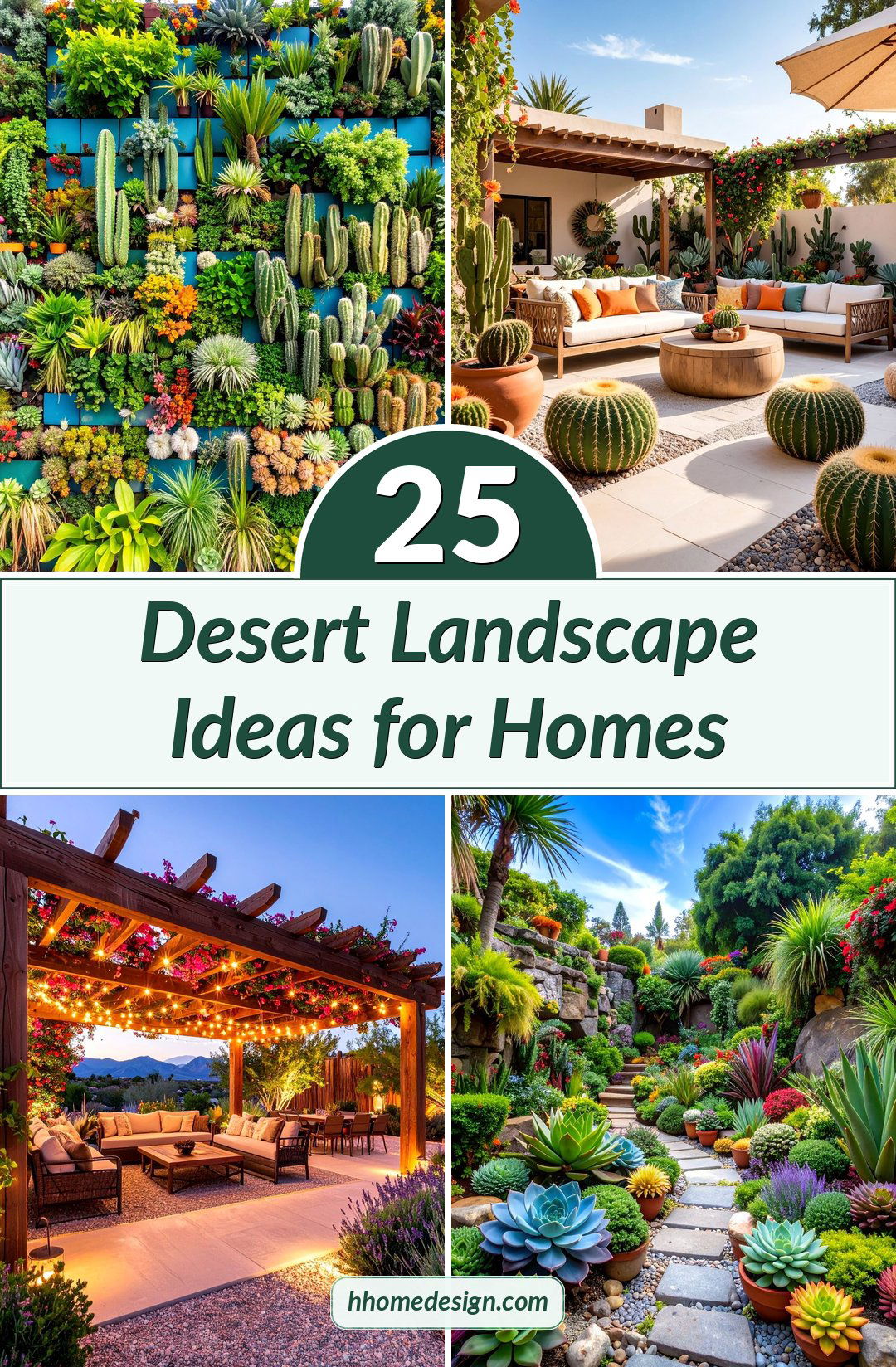
1. Southwestern Adobe Courtyard Garden
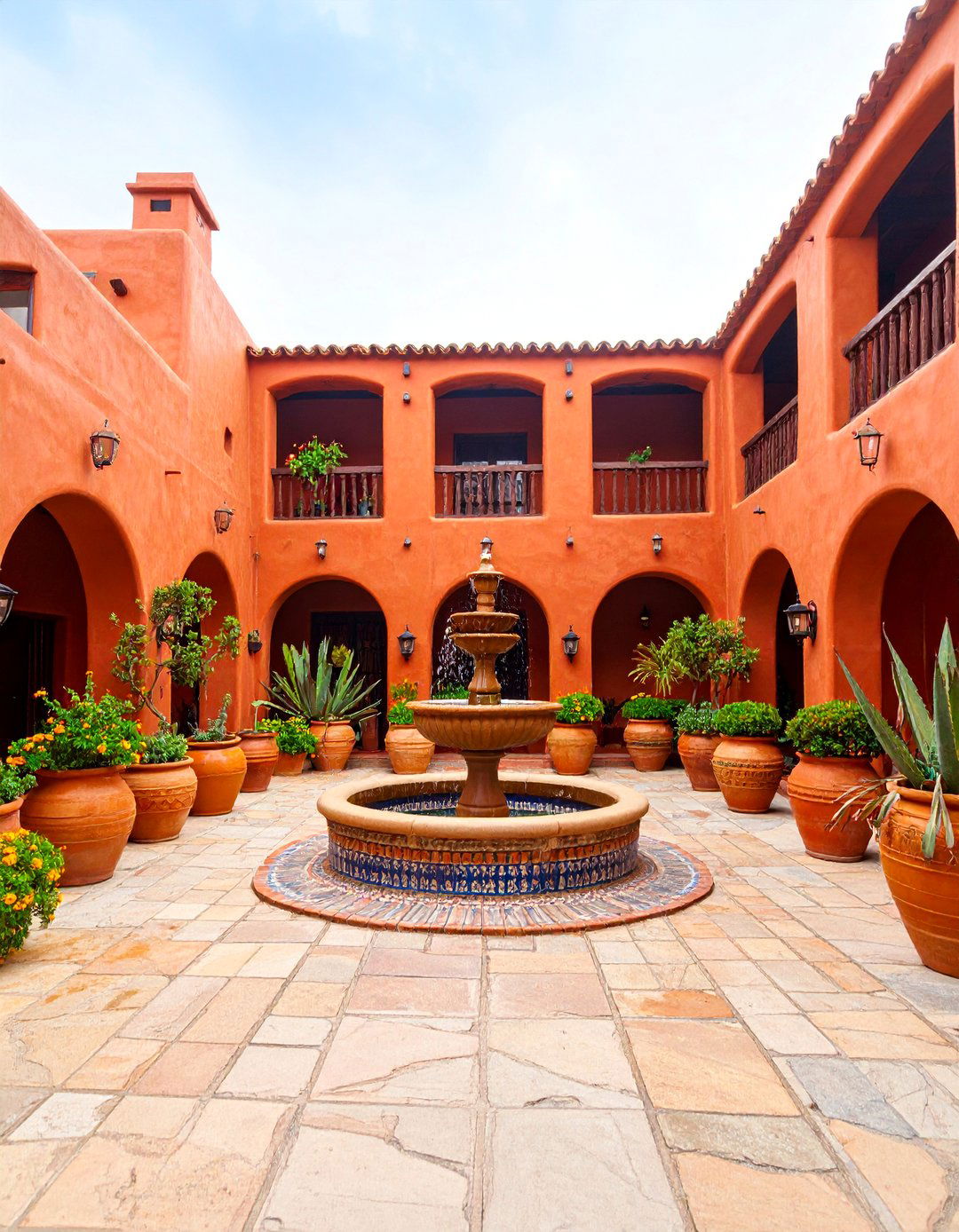
Traditional southwestern charm comes alive in this enclosed courtyard design featuring warm adobe walls, terra cotta accents, and vibrant desert plants. Colorful pottery adds artistic flair while native palo verde trees provide natural shade. Flagstone pathways meander through carefully placed agave clusters and blooming desert marigolds. The space includes a central fountain surrounded by Mexican tile work, creating a cooling focal point. Clay chimineas and wrought iron furniture complete the authentic southwestern atmosphere. This design celebrates regional heritage while providing a private oasis that captures the essence of Santa Fe and Arizona's historic architecture and landscape traditions.
2. Modern Minimalist Desert Zen Garden
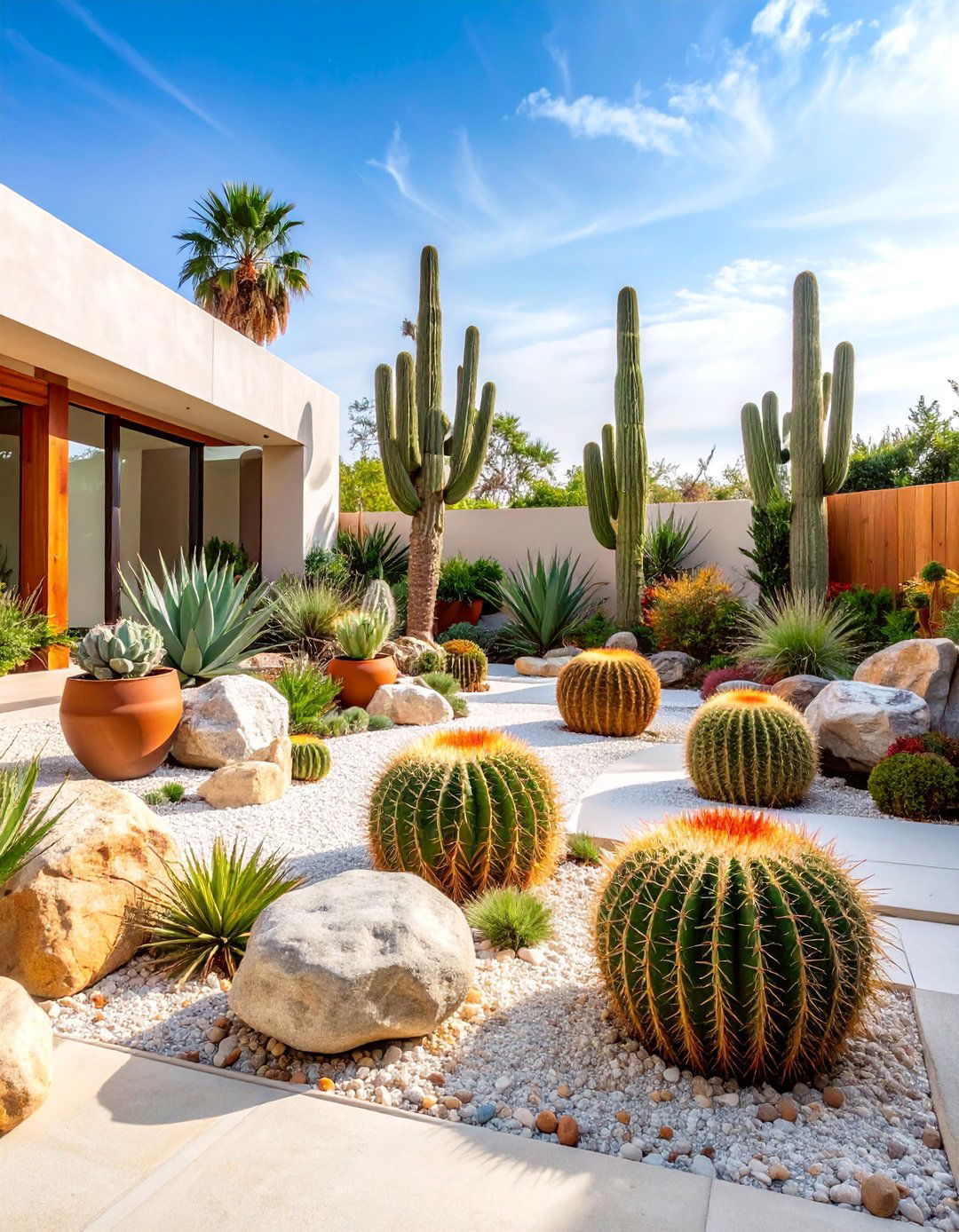
Clean geometric lines define this contemporary interpretation of traditional Japanese garden principles adapted for arid climates. Raked decomposed granite creates flowing patterns around carefully positioned boulders, while sparse plantings of barrel cacti and architectural agaves serve as living sculptures. A simple water feature provides gentle sound without excessive water usage. Steel planters contain drought-tolerant ornamental grasses that sway gracefully in desert breezes. The design emphasizes negative space and mindful plant placement, creating a meditative environment perfect for contemplation. This minimalist approach proves that desert gardens can embody tranquility and sophistication through intentional restraint and careful attention to form and texture.
3. Saguaro Cactus Showcase Garden
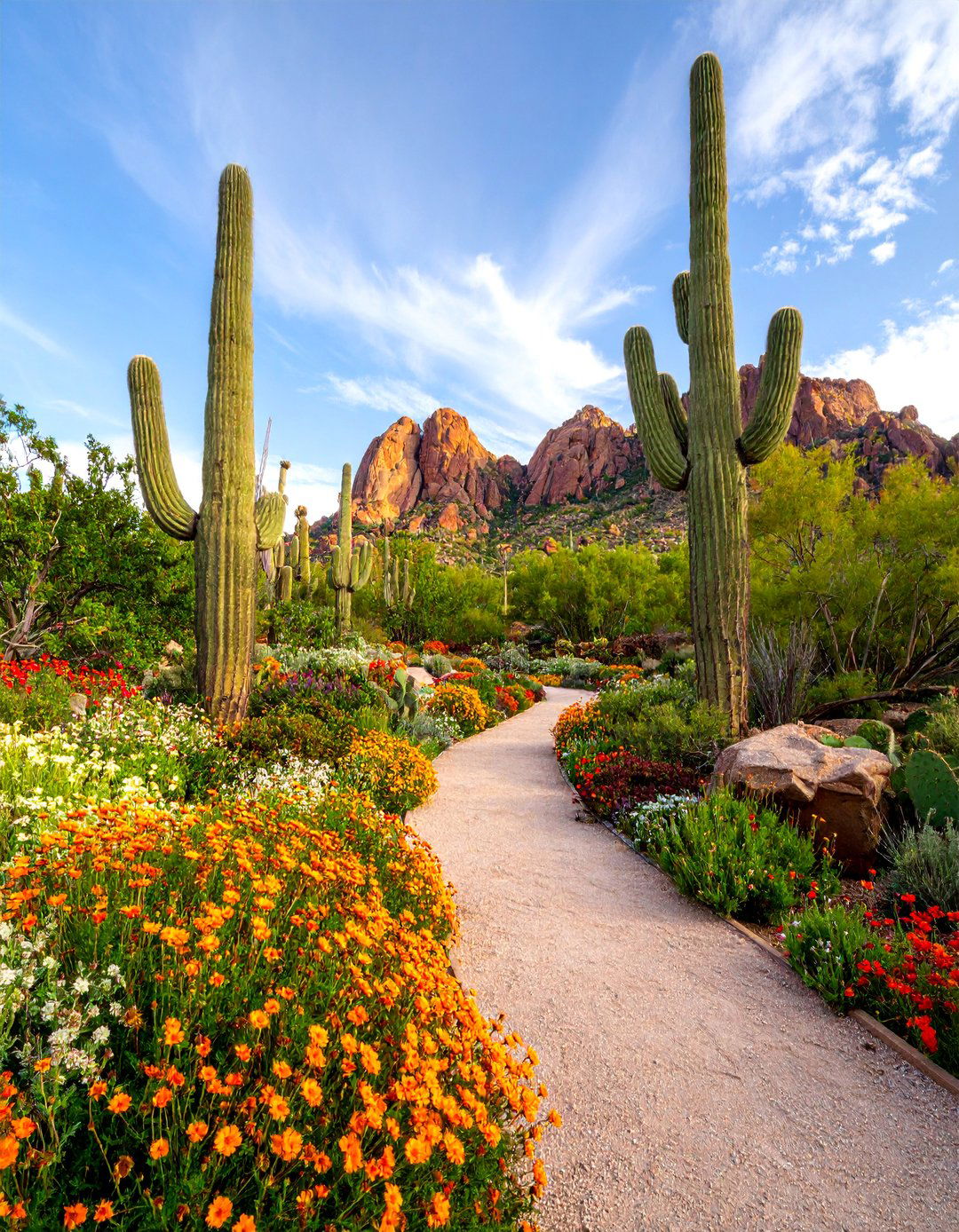
The iconic saguaro cactus takes center stage in this dramatic landscape celebrating America's most recognizable desert symbol. Multiple saguaros of varying heights create vertical interest while smaller desert plants including prickly pear, cholla, and brittlebush fill the understory. Decomposed granite pathways wind between these magnificent cacti, allowing visitors to appreciate their architectural beauty from multiple angles. Native wildflowers provide seasonal color bursts during brief blooming periods. Large boulders anchor the composition and provide textural contrast. This design requires minimal water once established and showcases the incredible diversity of Sonoran Desert flora while creating an authentic southwestern landscape experience.
4. Succulent Rock Garden Oasis
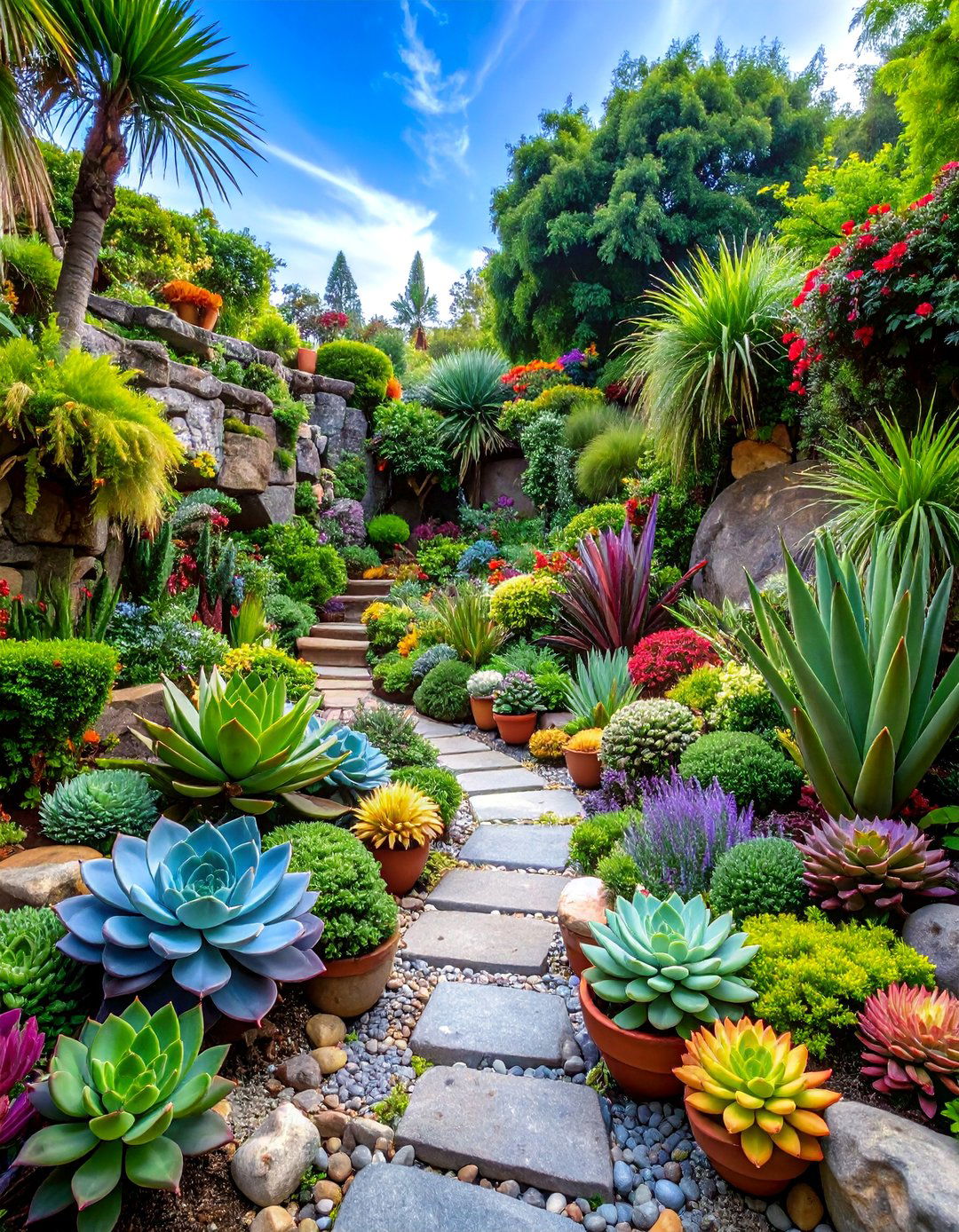
Tiered rock walls create dramatic elevation changes filled with colorful succulent varieties in this water-wise garden design. Different stone types including limestone, sandstone, and volcanic rock provide varied textures and drainage zones. Echeveria, sedum, and jade plants cascade over rock edges while taller aloe and agave species create focal points. Gravel mulch suppresses weeds and reflects light beautifully. Small pathways allow close inspection of plant details and seasonal changes. The design incorporates both common and rare succulent species, creating year-round interest through varied forms, colors, and textures. This approach maximizes plant diversity while minimizing water usage and maintenance requirements.
5. Desert Wildflower Meadow
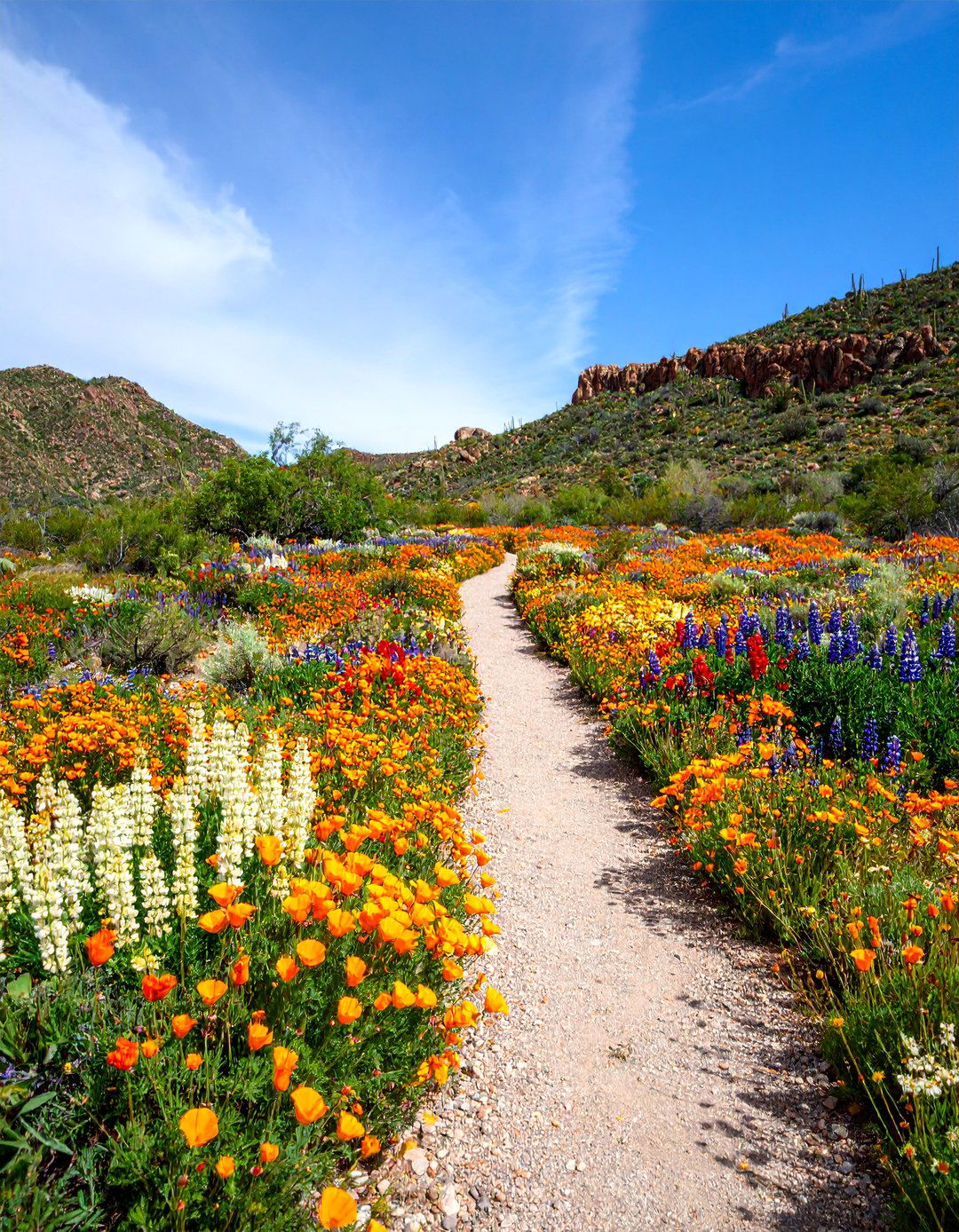
Seasonal desert wildflowers transform this landscape into a spectacular color display during brief but intense blooming periods. Native species including desert lupine, brittlebush, penstemon, and desert marigold create waves of purple, yellow, and orange across gently rolling terrain. Established shrubs like creosote bush and fairy duster provide structure between flowering seasons. Decomposed granite paths allow exploration without disturbing fragile root systems. The design includes interpretive signage highlighting native plant species and their ecological relationships. This naturalistic approach celebrates the ephemeral beauty of desert spring blooms while supporting local wildlife including native bees, hummingbirds, and desert tortoises throughout the year.
6. Agave and Yucca Sculpture Garden
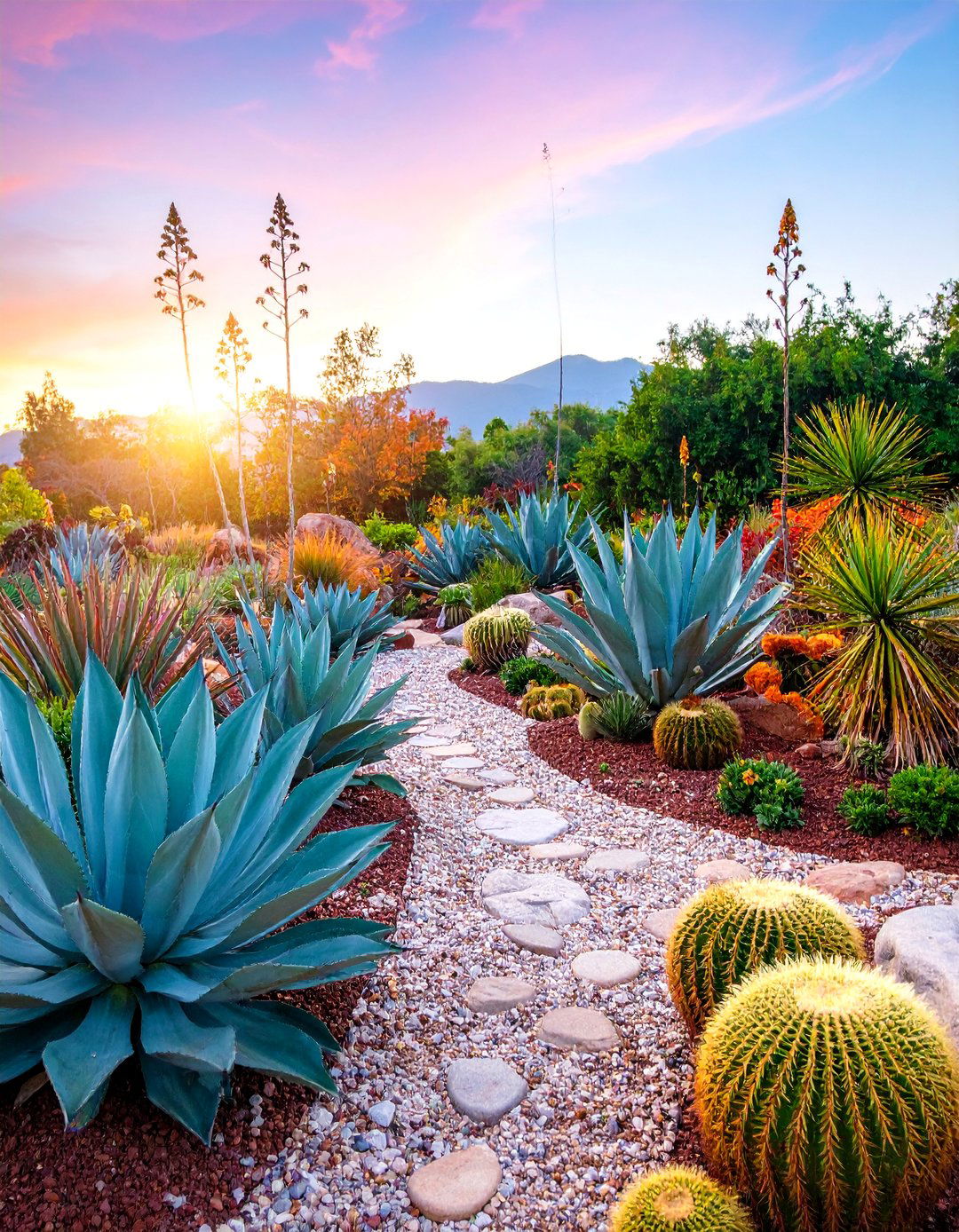
Architectural desert plants create living sculptures in this bold landscape featuring dramatic agave and yucca specimens. Century plants, blue agave, and various yucca species provide striking geometric forms enhanced by strategic lighting. Crushed granite surfaces in varying colors create subtle pathways and highlight individual plant specimens. Metal art pieces complement natural plant forms without competing for attention. The design emphasizes plant maturity and seasonal changes, including spectacular flowering stalks that emerge from mature specimens. Boulders provide scale reference and textural contrast. This garden celebrates the inherent artistry of desert plants while creating a low-maintenance landscape that becomes more dramatic with age.
7. Desert Pergola Entertainment Area

A rustic wooden pergola provides essential shade for outdoor entertaining in this desert landscape design. Climbing desert-adapted vines including bougainvillea create additional cooling while adding seasonal color. Decomposed granite flooring remains cool underfoot and requires minimal maintenance. Built-in seating incorporates weather-resistant materials designed for desert conditions. Surrounding plantings feature drought-tolerant options like Texas sage, desert willow, and ornamental grasses that provide privacy without blocking cooling breezes. String lighting creates evening atmosphere while fire bowls extend usability into cooler months. This design proves that desert landscapes can accommodate social gathering spaces while maintaining water efficiency and embracing regional plant palettes.
8. Cactus Container Garden Patio

Large decorative containers showcase diverse cacti collections in this flexible desert garden design perfect for small spaces or rental properties. Containers in various sizes, materials, and colors create visual interest while allowing plant mobility. Barrel cacti, prickly pear, and columnar species provide different forms and textures. Gravel mulch in containers prevents water retention issues while adding decorative appeal. The patio incorporates shade structures and seating areas surrounded by potted specimens. This approach allows experimentation with different plant combinations and seasonal arrangements. Container gardens offer excellent drainage control and enable gardeners to create impressive desert displays regardless of existing soil conditions or space limitations.
9. Desert Water Feature Courtyard
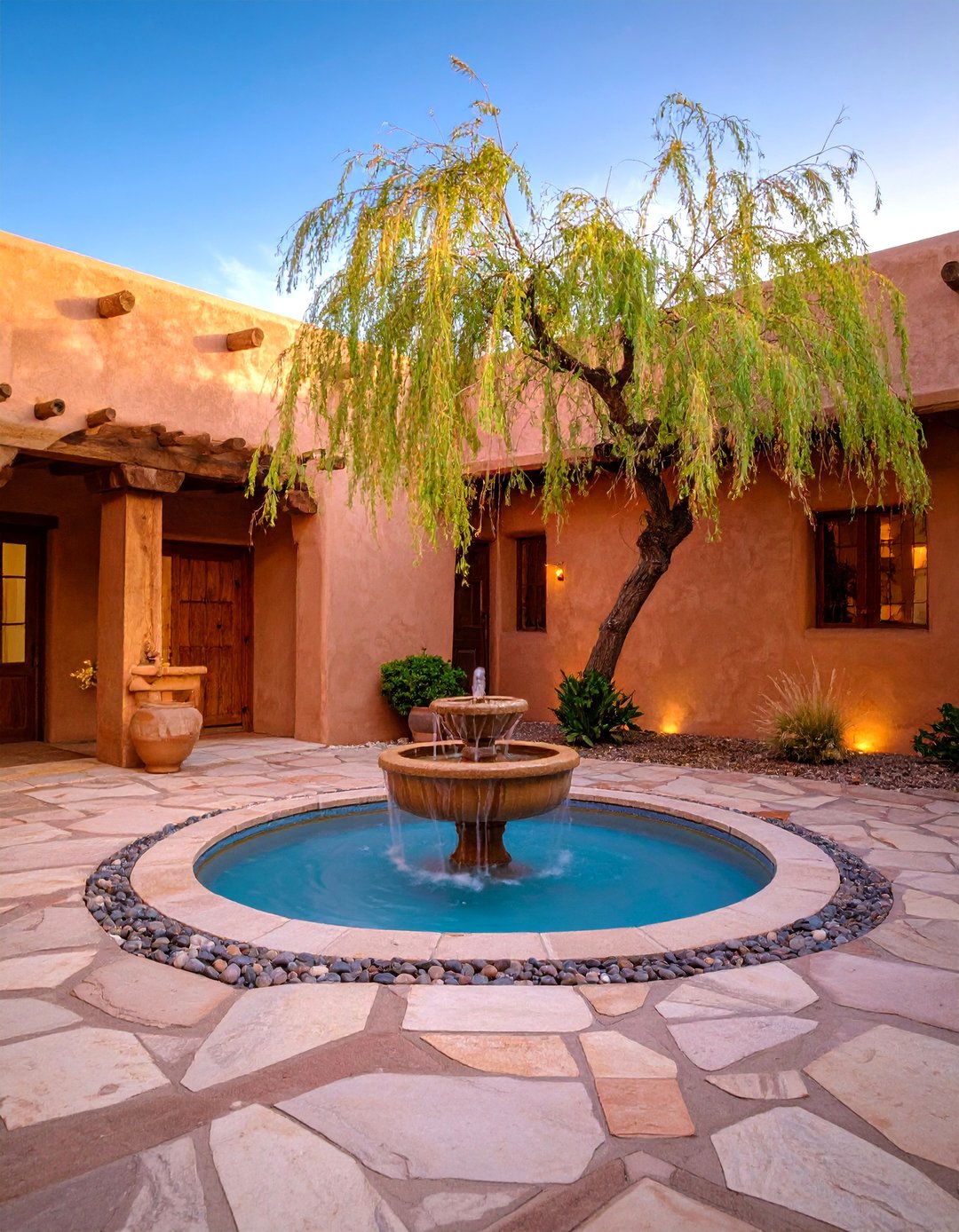
A carefully designed water feature becomes the cooling centerpiece of this intimate desert courtyard. The fountain recirculates water efficiently while creating soothing sounds that mask urban noise. Surrounding plantings include moisture-loving species like desert willow and fairy duster positioned to benefit from fountain spray. Flagstone paving reflects water sounds throughout the space while remaining cool underfoot. Adobe or stucco walls provide privacy and wind protection. Evening lighting illuminates both water movement and surrounding plant textures. This design demonstrates how water features can enhance desert landscapes when designed thoughtfully, creating microclimates that support slightly more lush plantings while maintaining overall water efficiency.
10. Gravel Garden Pathways
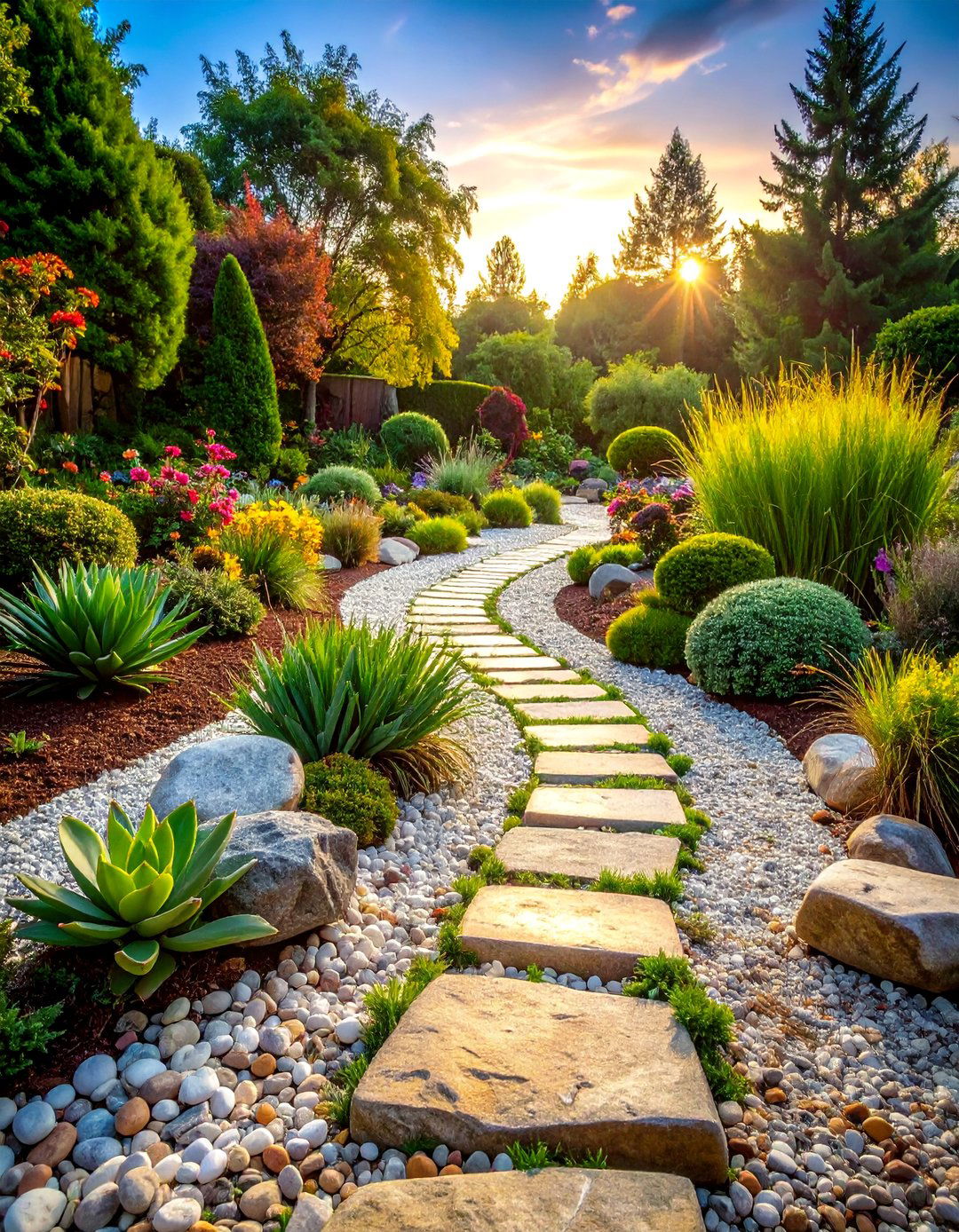
Decorative gravel in multiple colors and sizes creates beautiful pathways that connect different garden areas while providing excellent drainage. River rock, decomposed granite, and crushed stone create varied textures and visual interest. Pathways meander between planted areas, encouraging exploration and discovery. Strategic placement of stepping stones provides stable footing and design focal points. Surrounding desert plants including ornamental grasses and low-growing succulents soften pathway edges. The design incorporates subtle lighting along path edges for nighttime navigation. This approach combines functionality with aesthetic appeal while requiring minimal maintenance compared to traditional lawn or paved surfaces in desert environments.
11. Desert Meditation Garden Retreat
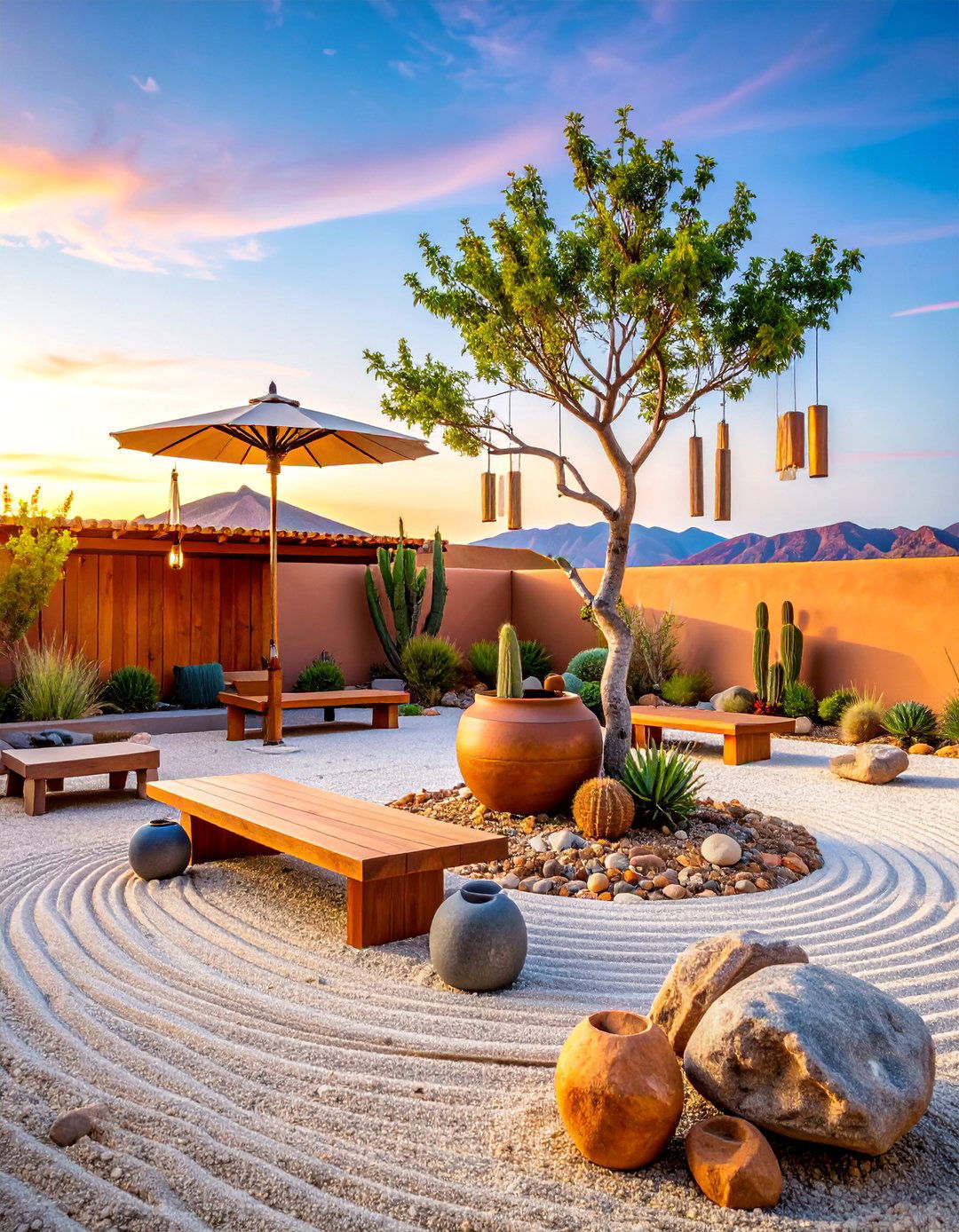
Simplified plant palettes and clean lines create a peaceful meditation space inspired by Zen principles but adapted for desert conditions. A single specimen tree like palo verde provides focal shade while maintaining the space's serene atmosphere. Raked gravel patterns encourage contemplation and provide meditative maintenance activity. Simple seating options include natural stone benches or weathered wood platforms. Sparse plantings of architectural specimens like barrel cacti or century plants serve as living focal points. Wind chimes and small water features add gentle sound elements. This garden design prioritizes mental wellness and spiritual connection with the desert environment through intentional simplicity and natural beauty.
12. Vertical Desert Garden Wall
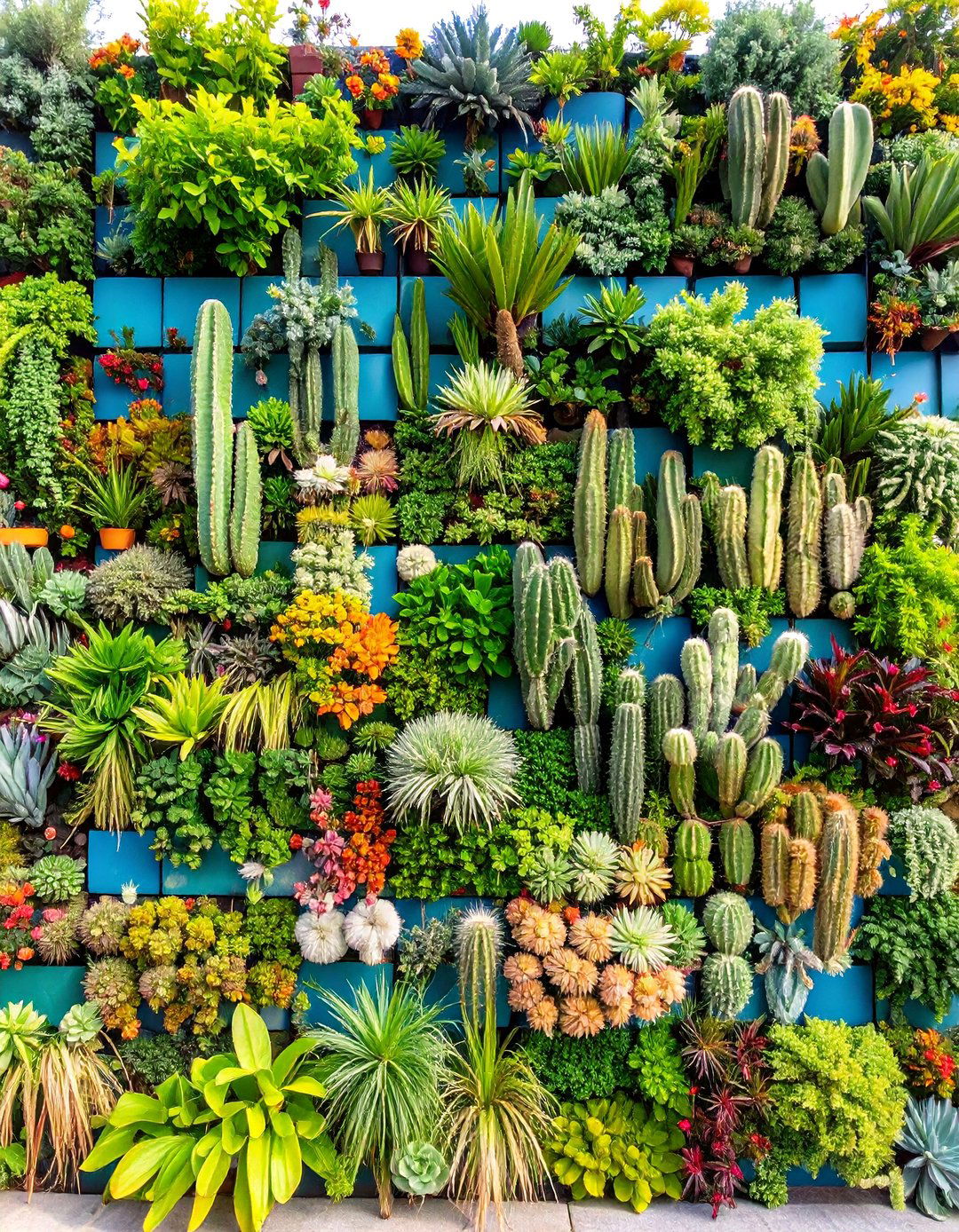
Living walls adapted for desert conditions create stunning vertical displays using drought-tolerant plants in specially designed mounting systems. Succulents, small cacti, and trailing varieties create textural tapestries against walls or fences. Efficient drip irrigation systems provide precise water delivery to individual plants. The design incorporates plants with varying colors, forms, and seasonal interest to maintain year-round appeal. Vertical gardens maximize planting space in small areas while creating dramatic focal points. This approach works particularly well for privacy screening, art installations, or space-efficient gardening. The vertical format showcases plant diversity while requiring minimal ground space and creating unique photogenic displays.
13. Boulder and Stone Feature Garden
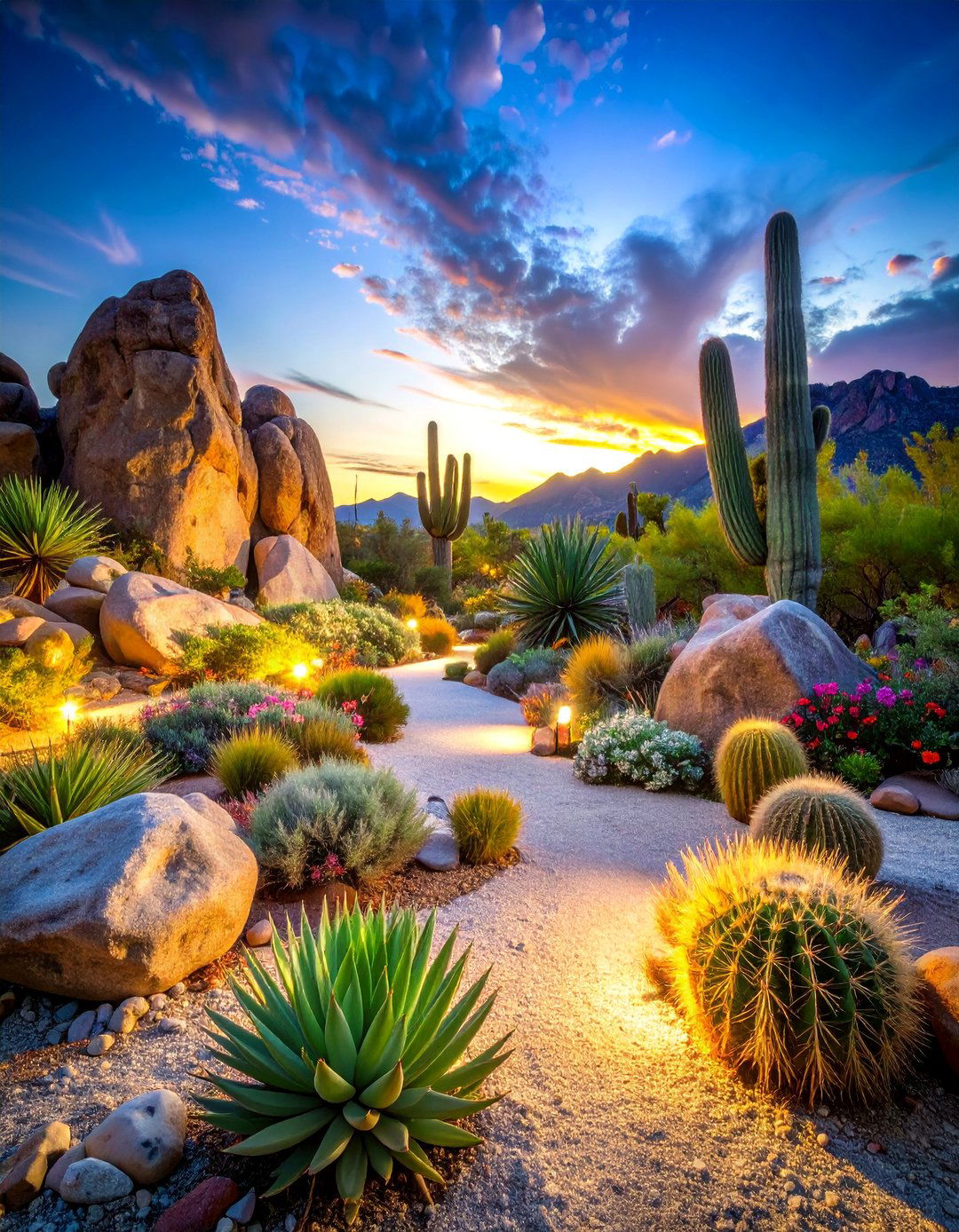
Large boulders and stone formations create dramatic landscape anchors surrounded by complementary desert plantings. Natural stone placement mimics desert washes and outcroppings while providing habitat for small wildlife. Plants including ghost plants, desert spoon, and prickly pear nestle naturally between rock formations. Decomposed granite surfaces connect stone groupings with flowing pathways. The design emphasizes natural erosion patterns and geological processes that shape desert landscapes. Strategic lighting highlights stone textures and plant forms during evening hours. This approach creates timeless landscapes that appear naturally weathered and established while providing low-maintenance beauty that improves with age as plants mature around stone features.
14. Desert Fire Pit Gathering Space
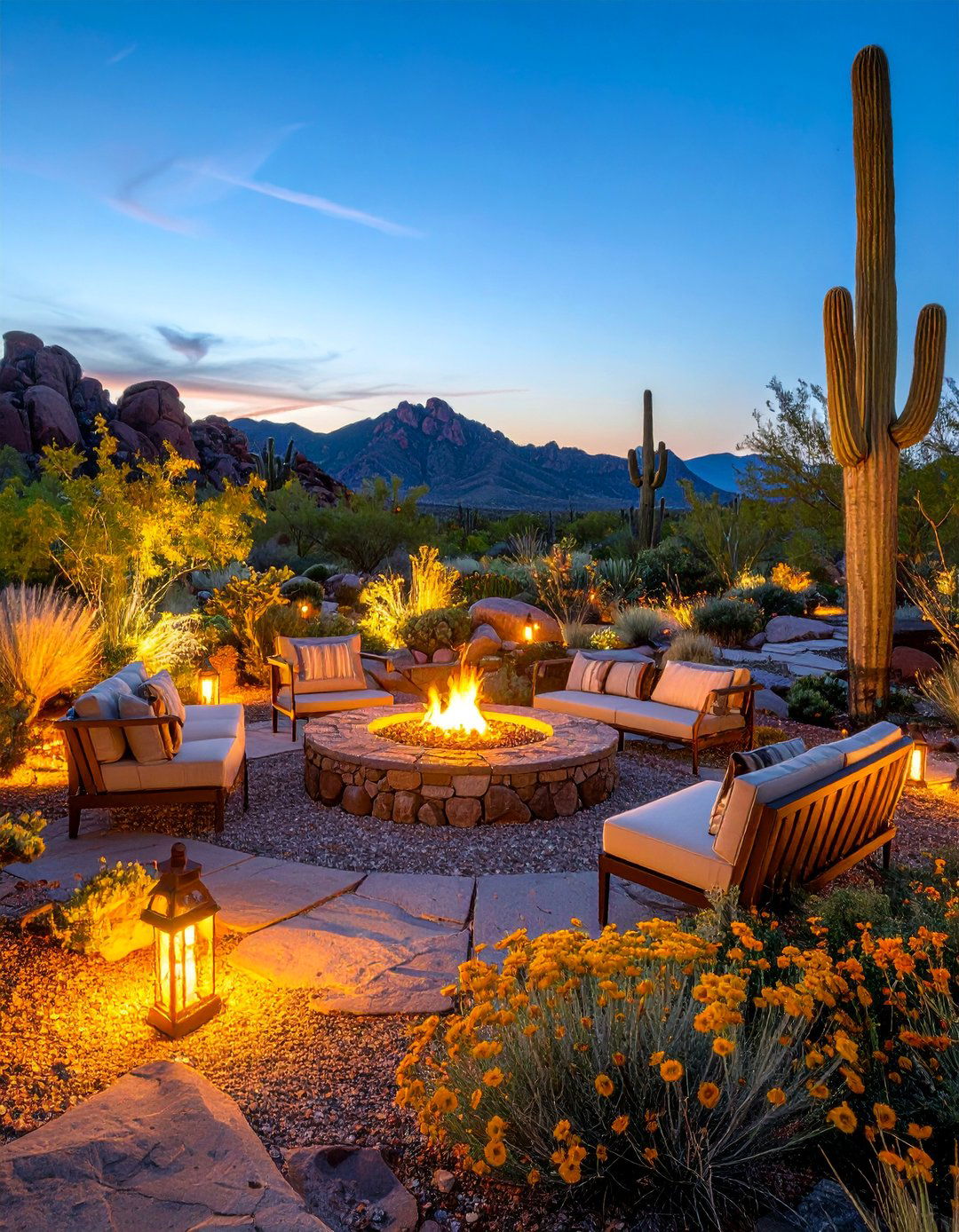
A central fire pit surrounded by drought-tolerant landscaping creates an inviting social space for desert evenings. Native stone or metal fire rings provide safe contained flames while complementing natural desert aesthetics. Seating areas incorporate weather-resistant materials positioned to take advantage of cooling breezes. Surrounding plantings feature fire-resistant species like desert broom and brittlebush that maintain safe distances from heat sources. Decomposed granite surfaces remain stable and attractive around seating areas. The design includes subtle pathway lighting and strategically placed accent plants. This outdoor living concept extends usability of desert landscapes into cooler months while creating focal points for entertainment and relaxation activities.
15. Native Desert Tree Canopy Garden
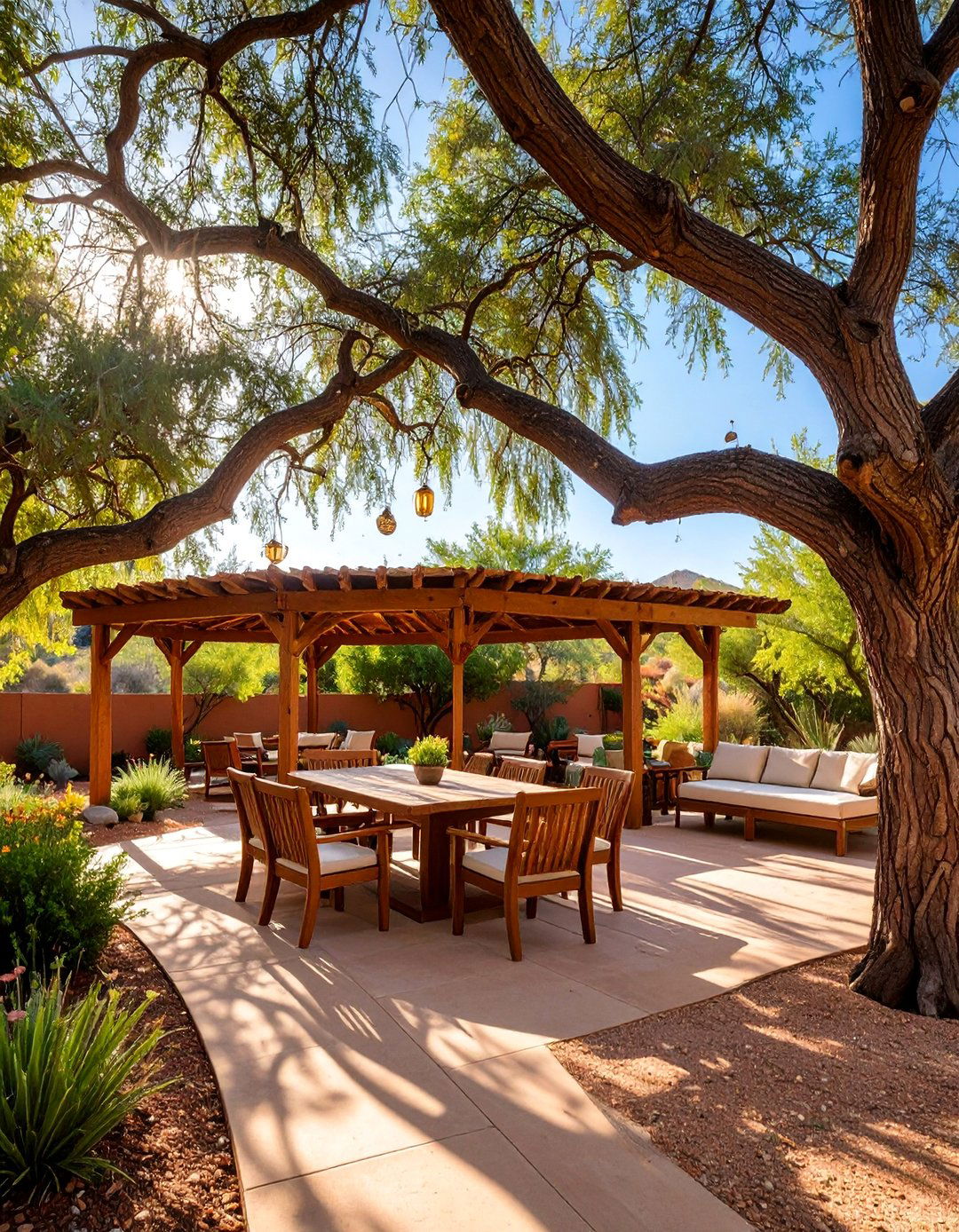
Mature native trees including mesquite, palo verde, and desert willow create natural shade structures supporting understory plantings. Tree canopies moderate ground temperatures, enabling slightly more diverse plant communities beneath their protection. Understory plants include desert-adapted species that benefit from filtered sunlight and reduced wind exposure. Mulched areas beneath trees conserve soil moisture while suppressing weeds. The design incorporates seating and pathway systems that respect mature tree root systems. This approach demonstrates how native trees can anchor desert landscapes while providing environmental benefits including wildlife habitat, erosion control, and natural cooling. Mature specimens become increasingly valuable focal points as they develop distinctive growth patterns.
16. Decomposed Granite Pathway System
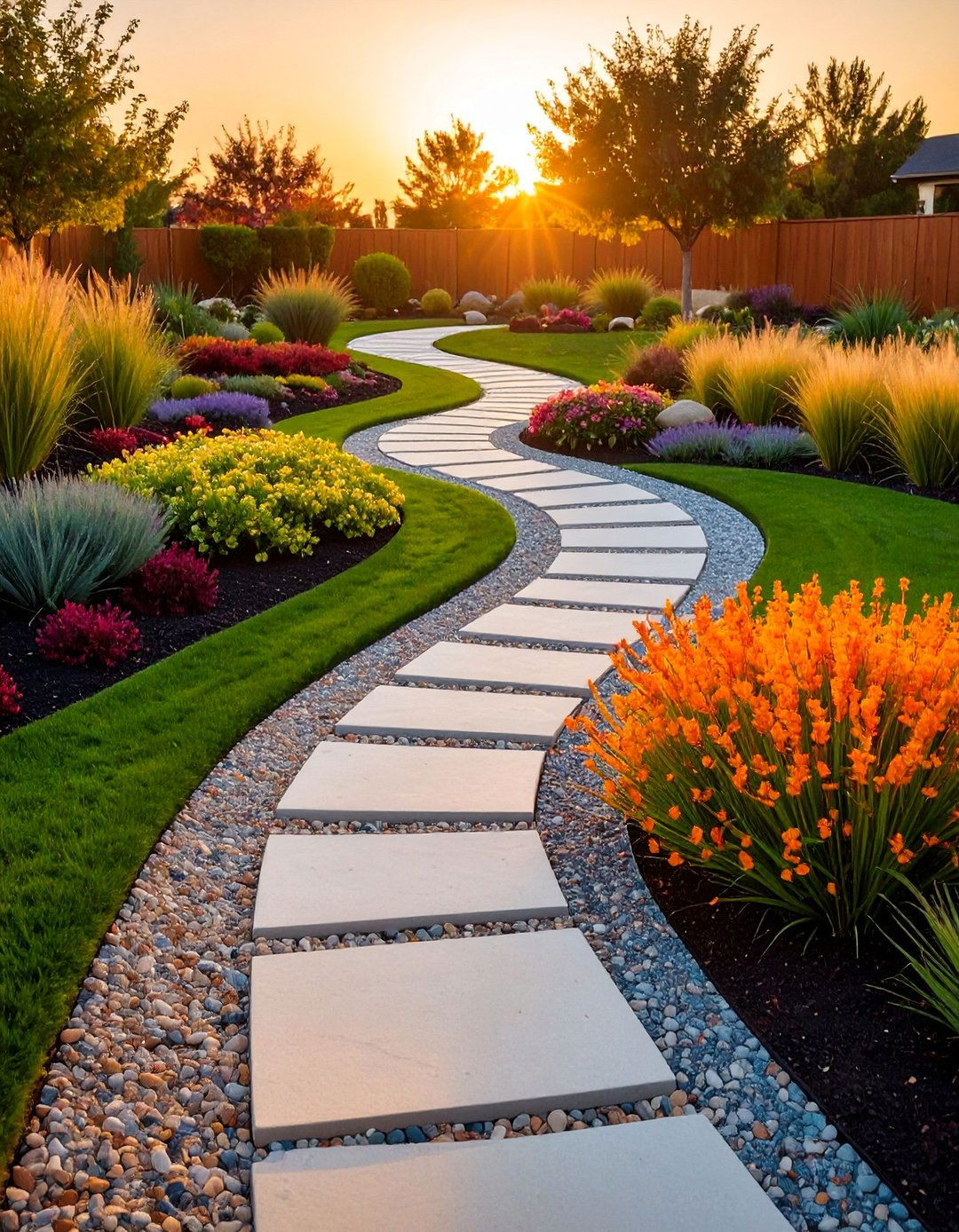
Extensive decomposed granite pathway networks create accessible circulation throughout desert gardens while maintaining natural aesthetics. Pathways connect different garden zones including seating areas, water features, and specimen plant displays. Varying pathway widths accommodate different uses from maintenance access to leisurely strolling. Strategic placement of stepping stones provides textural variety and stable footing during occasional rain events. Pathway edges feature subtle plant borders including ornamental grasses and low-growing succulents. The design incorporates gentle curves that follow natural terrain while providing universal accessibility. This system creates cohesive garden organization while remaining permeable and environmentally appropriate for desert conditions.
17. Desert Pollinator Garden
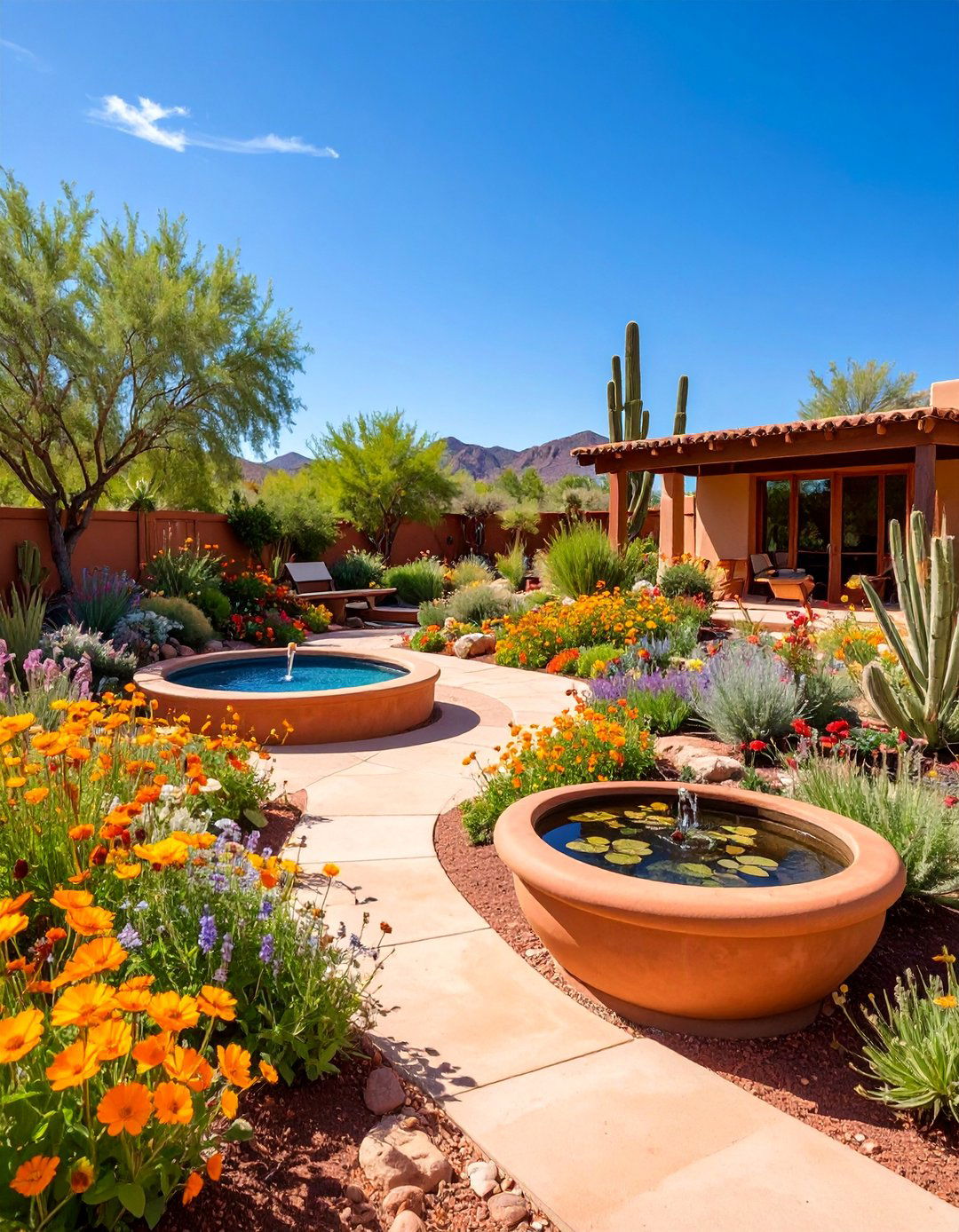
Native flowering plants create seasonal nectar sources supporting desert wildlife including hummingbirds, butterflies, and native bees. Plant selections include penstemon, desert marigold, fairy duster, and ghost plant that provide extended blooming periods. The design incorporates plants with varying bloom times to ensure continuous food sources throughout growing seasons. Water features include shallow dishes and dripping fountains that provide essential drinking opportunities for pollinators. Native shrubs offer nesting sites and shelter. This ecological approach demonstrates how desert landscapes can support biodiversity while maintaining water efficiency. Educational elements including plant identification and seasonal bloom calendars enhance visitor understanding of desert ecology and conservation.
18. Contemporary Desert Courtyard
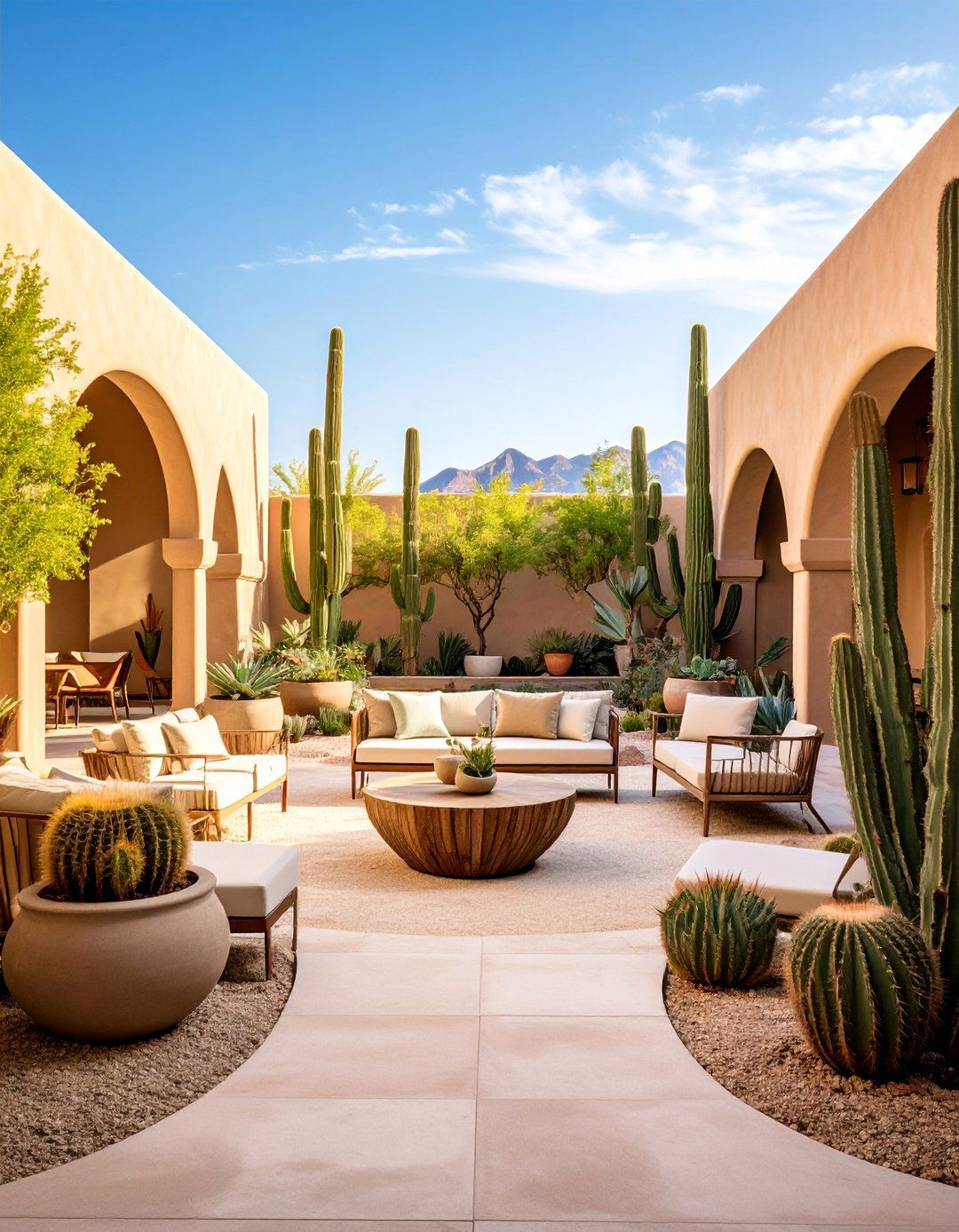
Clean architectural lines and modern materials create sophisticated desert courtyards emphasizing geometric plant arrangements and minimalist aesthetics. Concrete planters in various sizes contain carefully selected specimens including architectural agaves and columnar cacti. Steel water features provide contemporary focal points while maintaining water efficiency. Decomposed granite surfaces in neutral tones complement modern architecture. The design incorporates subtle accent lighting and weather-resistant contemporary furniture. Plant selections emphasize form over color, creating sophisticated compositions that complement modern building design. This approach appeals to homeowners seeking low-maintenance landscapes that enhance contemporary architecture while embracing regional climate and plant communities.
19. Desert Privacy Screening Garden
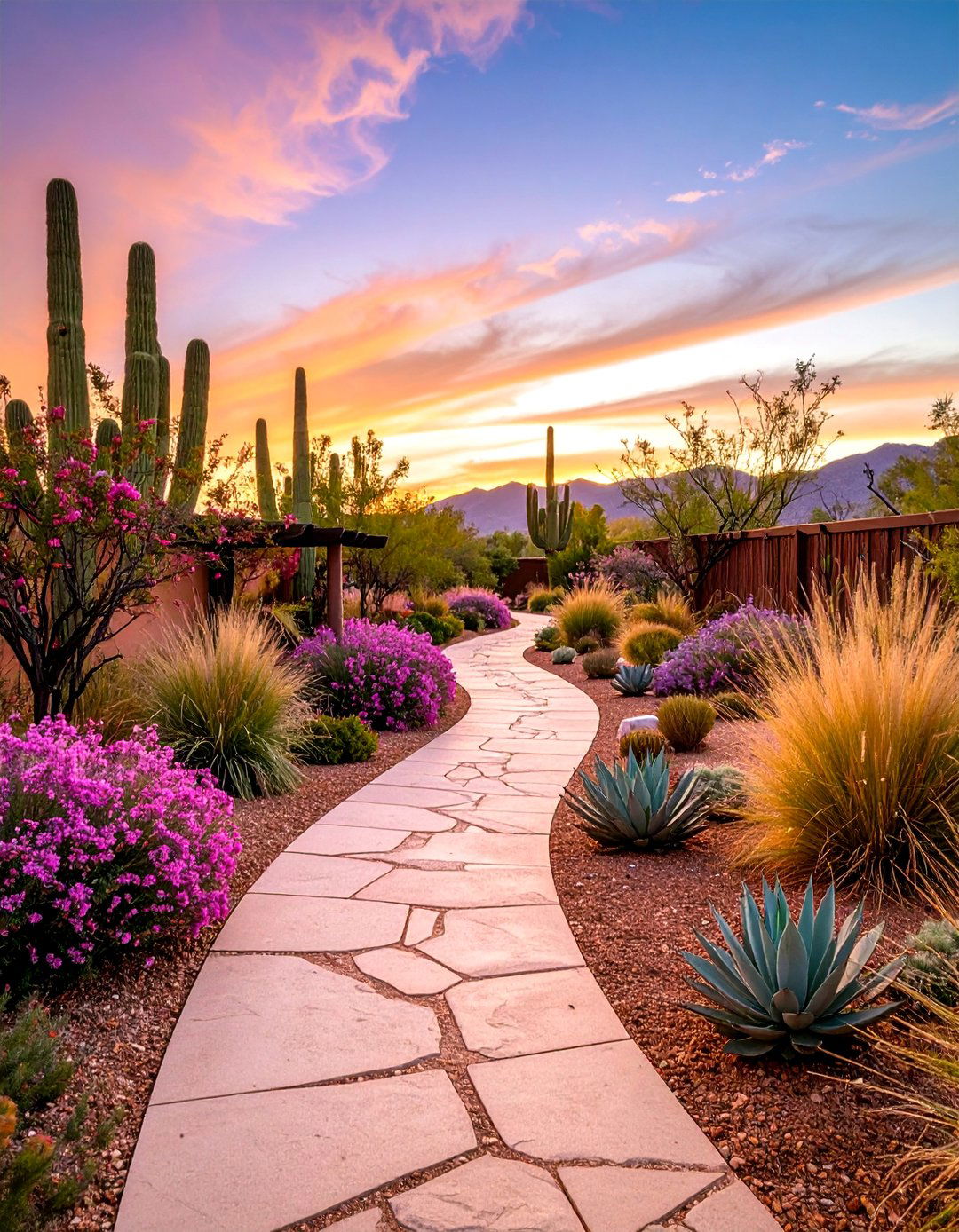
Strategic plant placement creates natural privacy barriers using drought-tolerant species that thrive in desert conditions. Tall-growing options include oleander, Texas sage, and desert broom arranged in layered compositions. Lower plantings of ornamental grasses and spreading succulents provide complete screening at various heights. The design incorporates seasonal interest through plants with attractive flowers, berries, or fall color. Pathways wind between screening plants, creating intimate garden rooms and discovery opportunities. This approach provides property privacy without requiring extensive irrigation or maintenance typical of traditional hedge materials. Mature plantings create increasingly effective screening while supporting local wildlife and requiring minimal ongoing care.
20. Desert Shade Garden Microclimate
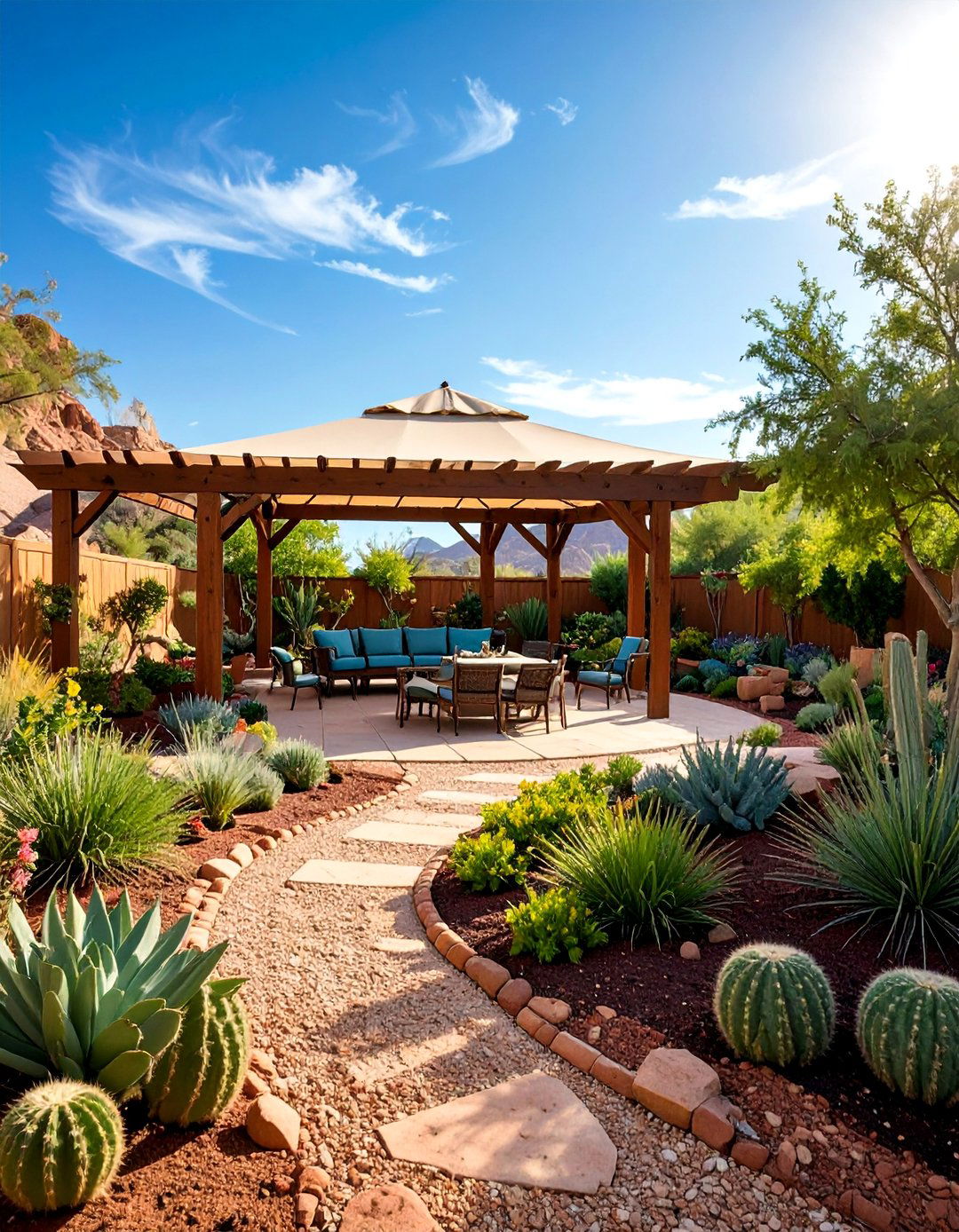
Strategic shade creation enables cultivation of plants typically not associated with desert conditions. Pergolas, shade cloth, or mature trees create protected microclimates supporting slightly more water-loving species. Plants might include desert-adapted varieties of traditional garden favorites or species from higher elevation desert regions. The design incorporates efficient irrigation systems that provide targeted watering to shade garden areas. Decomposed granite pathways connect shade areas with surrounding desert plantings. This concept demonstrates how thoughtful design can expand planting possibilities within desert landscapes while maintaining overall water efficiency. Shade gardens provide cooling relief and demonstrate the diversity possible within xeriscaped environments.
21. Seasonal Desert Color Garden
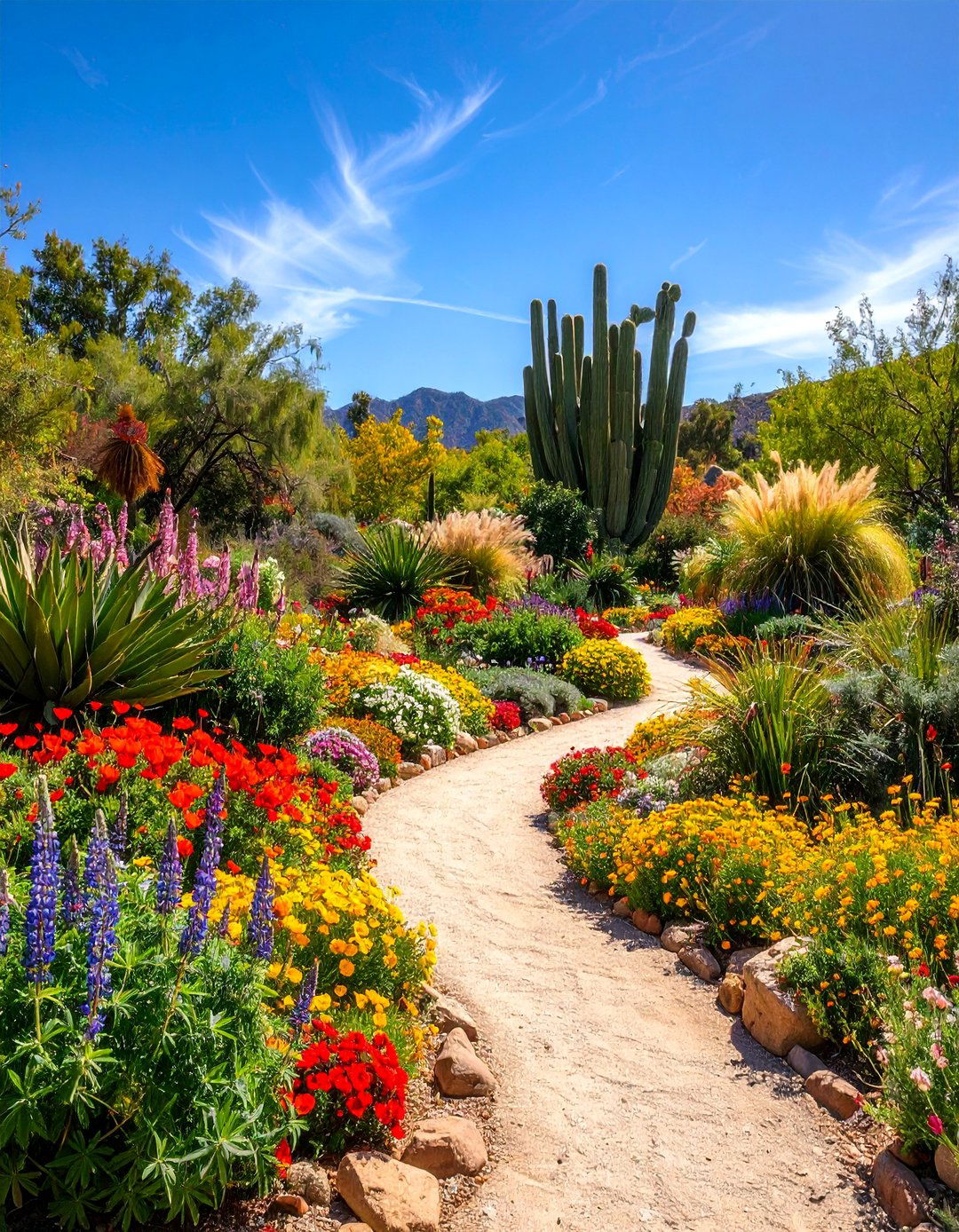
Carefully timed plantings create spectacular seasonal color displays that celebrate desert blooming cycles. Spring displays feature desert lupine, poppies, and brittlebush creating waves of color across landscape areas. Summer focus shifts to heat-tolerant bloomers like desert willow and fairy duster. Fall brings ornamental grass seed heads and late-season wildflowers. The design incorporates evergreen structural plants that provide year-round interest between blooming periods. Pathways allow close observation of seasonal changes and plant development cycles. This approach showcases the surprising diversity and beauty of desert plant communities while providing educational opportunities about desert ecology and plant adaptation strategies.
22. Desert Mosaic Rock Garden
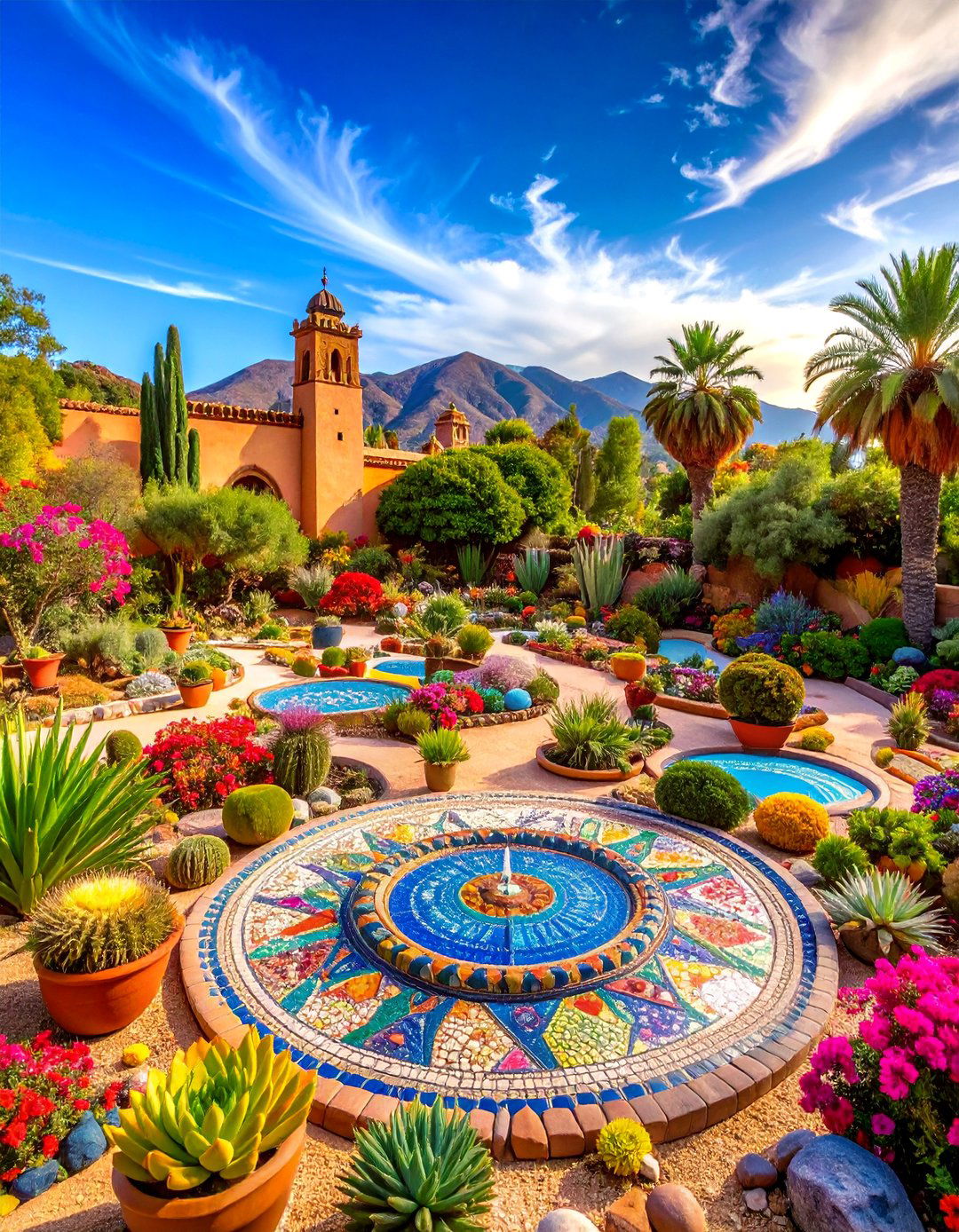
Intricate patterns created with different colored gravels, sands, and small stones form artistic designs throughout planted areas. Mosaic elements might include geometric patterns, flowing designs, or representational images using natural materials. Drought-tolerant plants provide living elements within artistic compositions. The design requires careful planning and installation but creates unique artistic landscapes. Maintenance involves periodic pattern refreshing and weed control. This approach combines gardening with landscape art, creating one-of-a-kind installations that reflect personal creativity while embracing desert materials and plants. Mosaic elements can incorporate cultural themes, personal symbols, or abstract designs that complement surrounding architecture and plant communities.
23. Desert Outdoor Kitchen Garden

Culinary herbs and edible plants adapted to desert conditions surround outdoor cooking and dining areas. Heat-tolerant herbs like rosemary, oregano, and desert sage provide fresh ingredients while requiring minimal water. Fruit trees including pomegranate, fig, and desert-adapted citrus varieties provide shade and seasonal harvests. The design incorporates raised planters and container gardens that enable soil amendment and targeted irrigation. Pathways connect cooking areas with herb and vegetable plots. This functional approach demonstrates how desert landscapes can provide both beauty and culinary resources while maintaining water efficiency and low-maintenance requirements appropriate for desert climates.
24. Desert Artistic Sculpture Garden
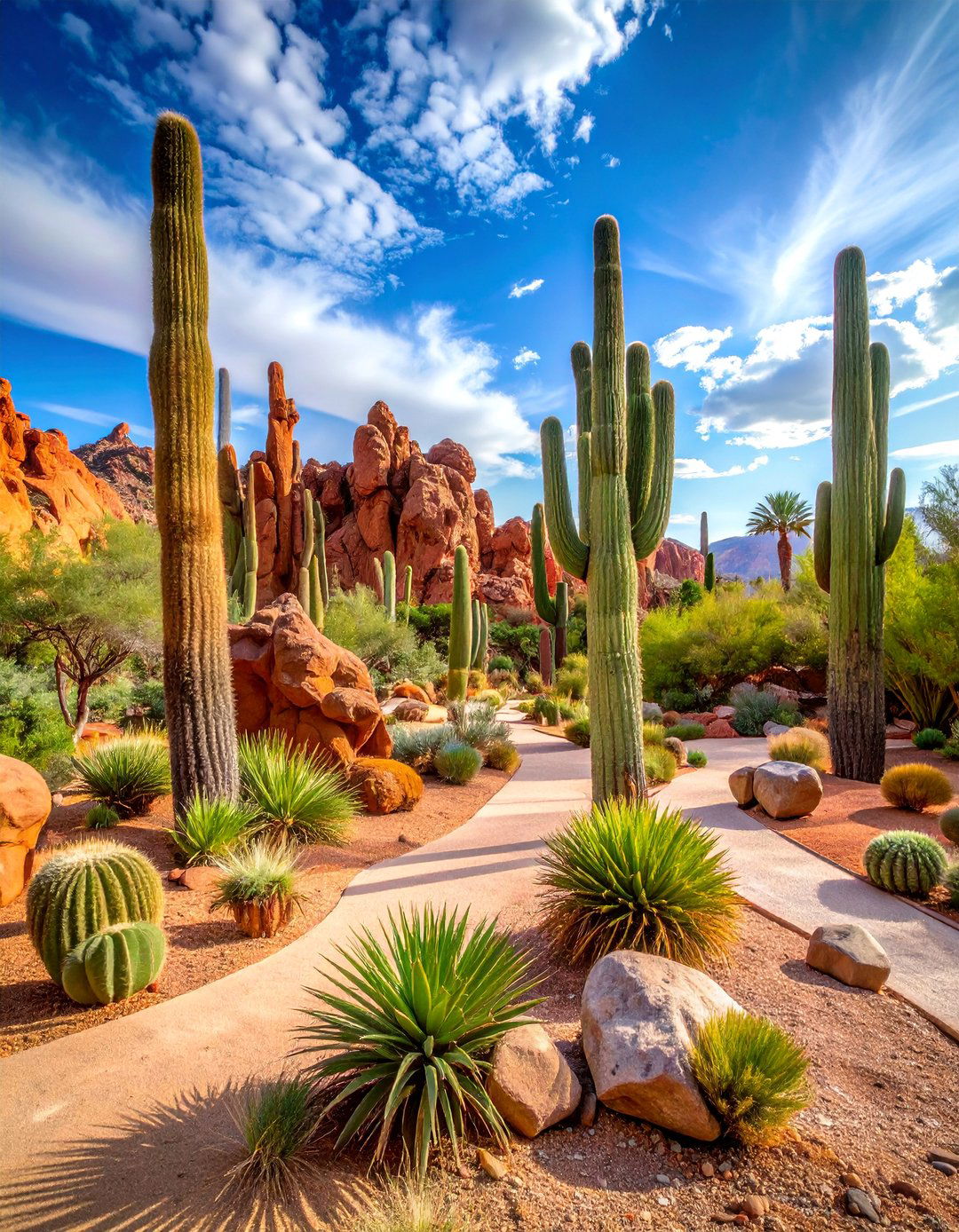
Large-scale art installations integrate with desert plantings to create gallery-quality outdoor spaces. Sculptures might include metal work, stone carvings, or contemporary installations that complement natural desert forms. Plant selections provide appropriate scale and seasonal interest without overwhelming artistic elements. Pathways guide visitors through outdoor gallery experiences while protecting both art and plants. Lighting systems highlight both sculptural elements and plant specimens during evening hours. This approach appeals to art collectors and culturally minded homeowners seeking sophisticated landscape installations. The combination of art and desert plants creates unique outdoor experiences that change seasonally while maintaining year-round visual interest and cultural significance.
25. Budget-Friendly Desert Starter Garden

Cost-effective desert landscaping approaches enable beautiful results without significant financial investment. Plant selections emphasize easily propagated species like prickly pear, barrel cactus, and common succulents that can be obtained inexpensively. Decomposed granite and locally sourced rocks provide affordable hardscaping materials. The design incorporates plant swaps, native plant society sales, and propagation techniques to build plant collections economically. Simple irrigation systems including drip emitters provide efficient watering without complex installation requirements. This approach demonstrates how attractive desert landscapes can be achieved through careful plant selection, DIY installation, and community resource utilization while creating foundations for future garden expansion.
Conclusion:
Desert landscaping represents a sustainable and beautiful approach to outdoor design that works harmoniously with natural conditions rather than fighting against them. These twenty-five ideas demonstrate the incredible diversity possible within water-wise gardening, from intimate meditation spaces to expansive entertainment areas. By embracing native plants, efficient irrigation, and creative hardscaping, desert landscapes provide year-round beauty while supporting local ecosystems. Whether implementing a single concept or combining multiple approaches, these designs prove that desert environments offer unlimited opportunities for creating remarkable outdoor spaces that celebrate the unique beauty of arid landscapes.





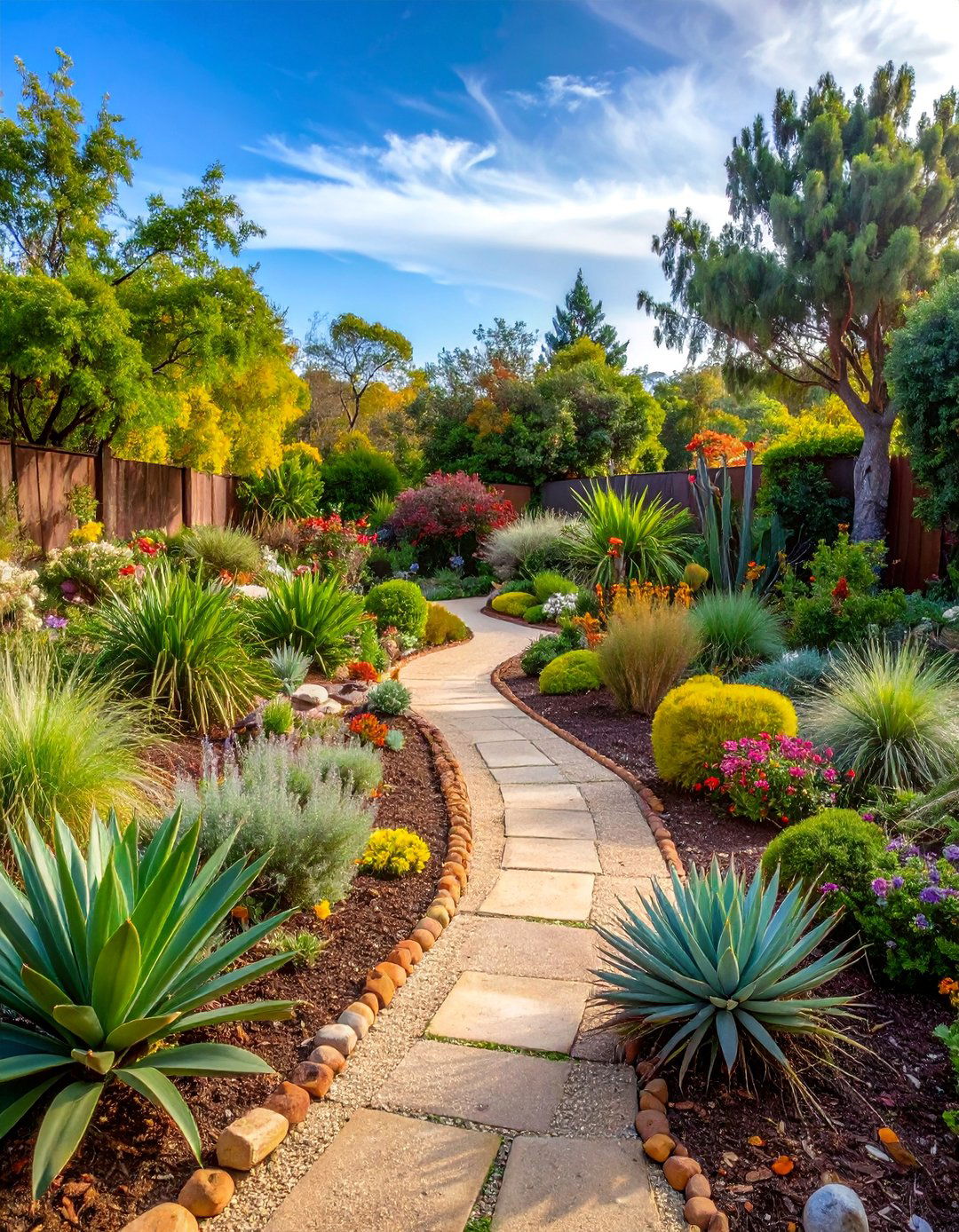
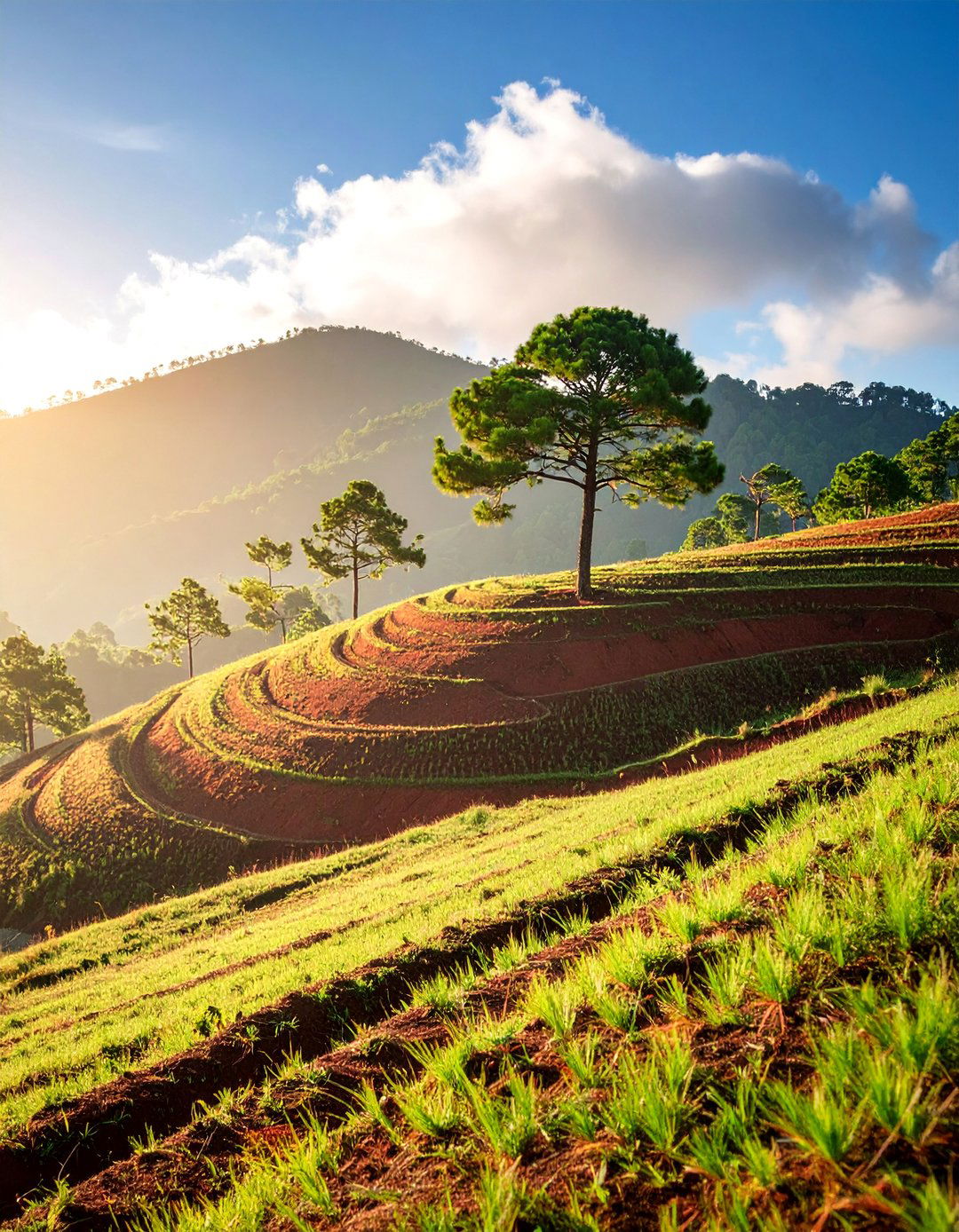

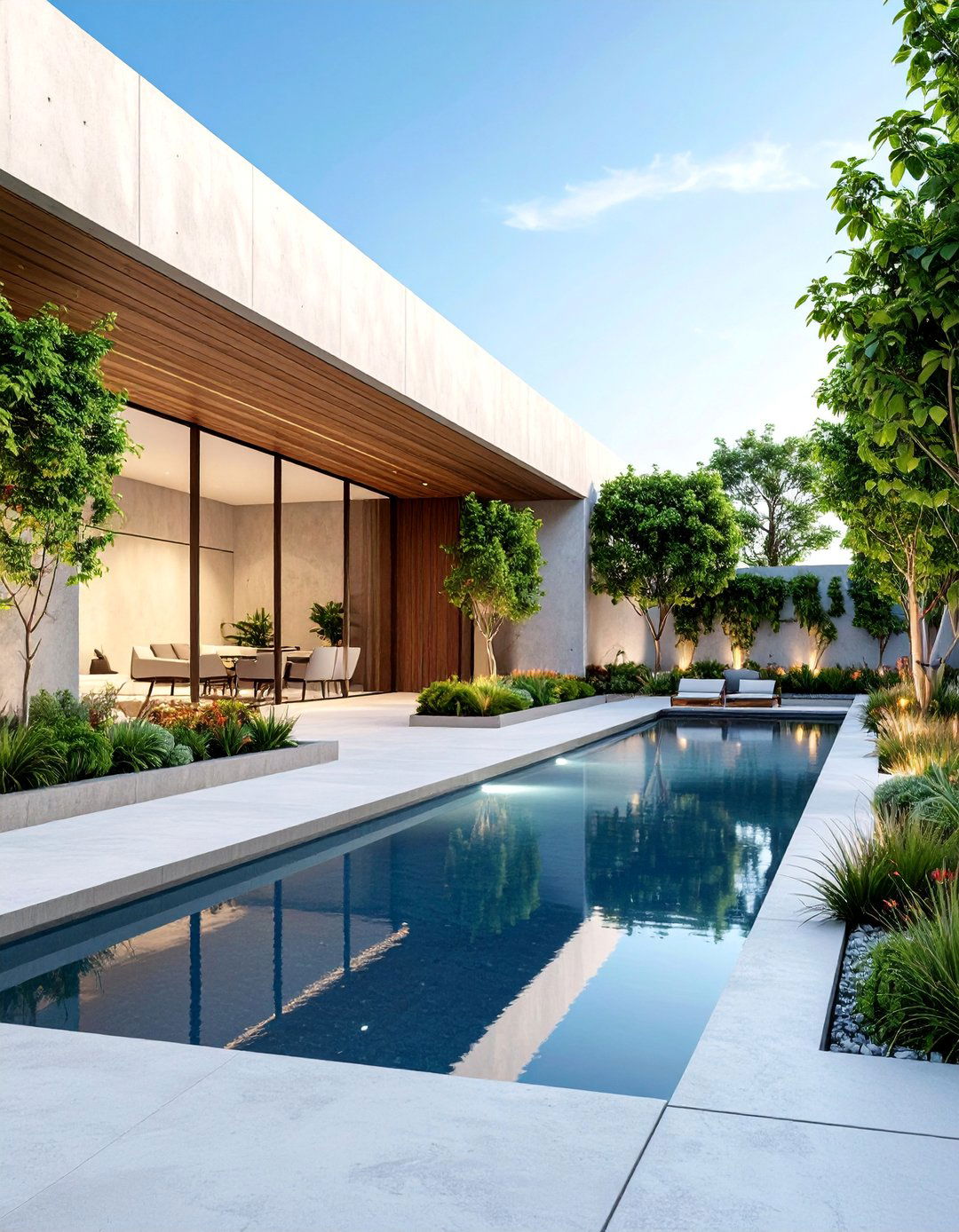
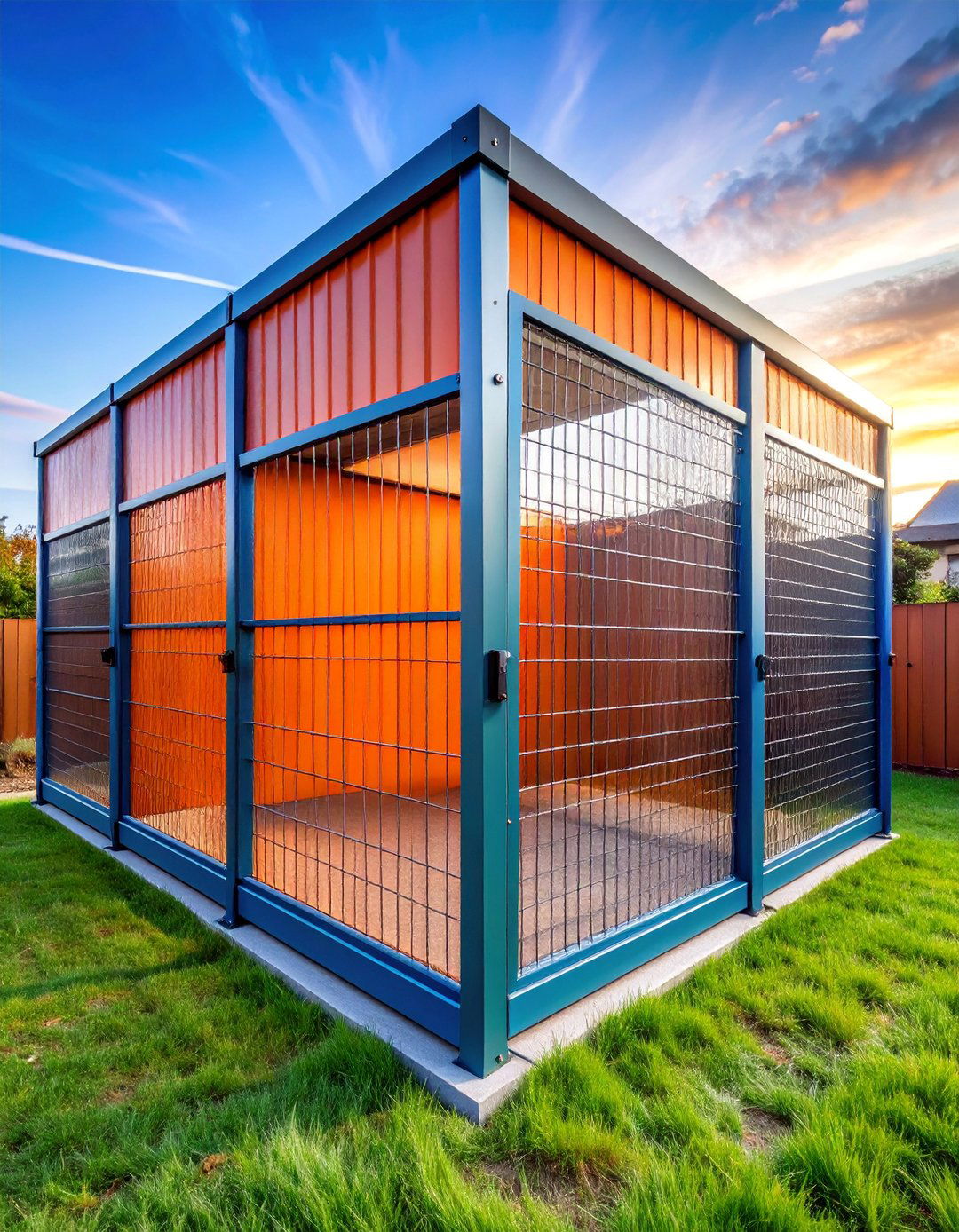

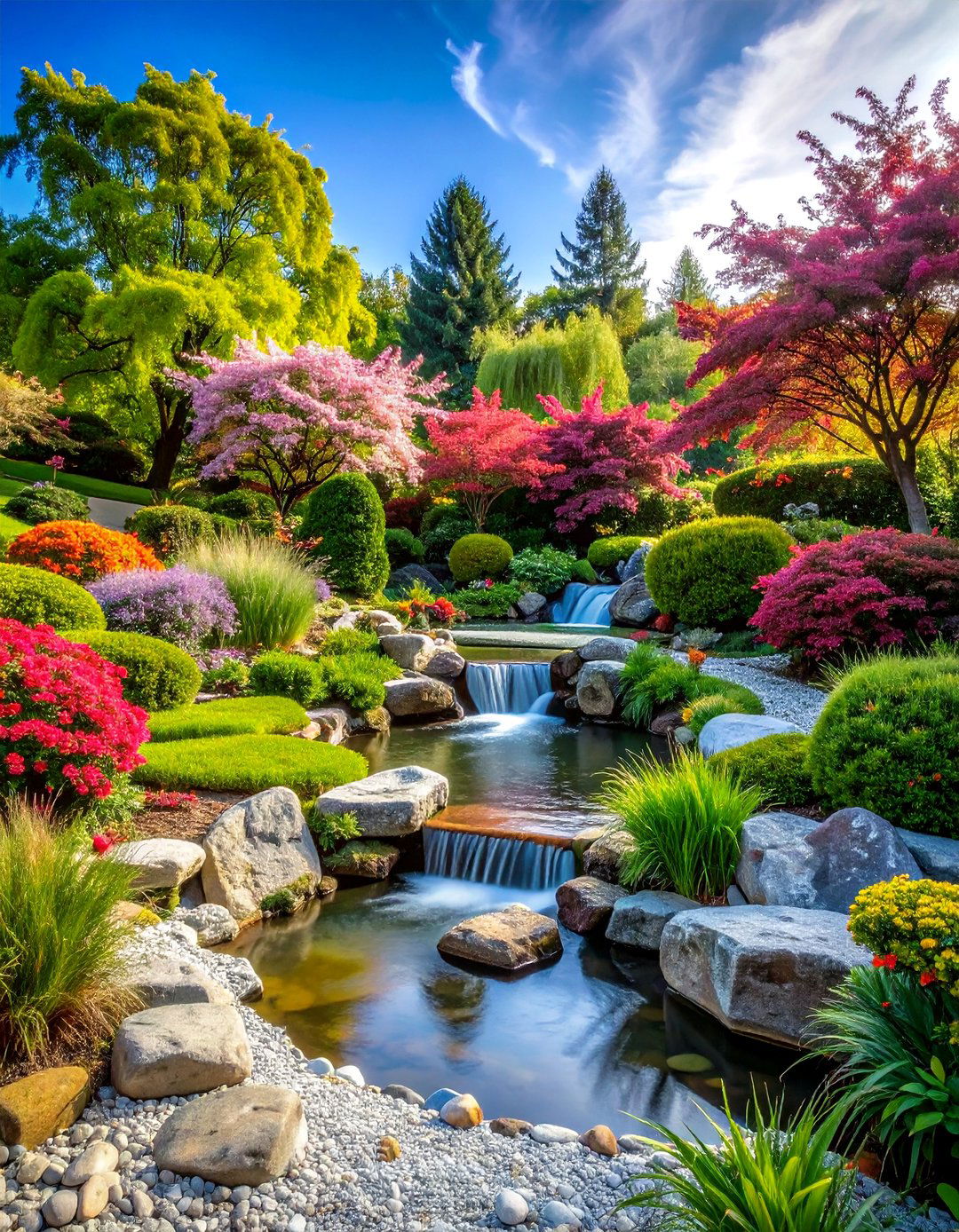
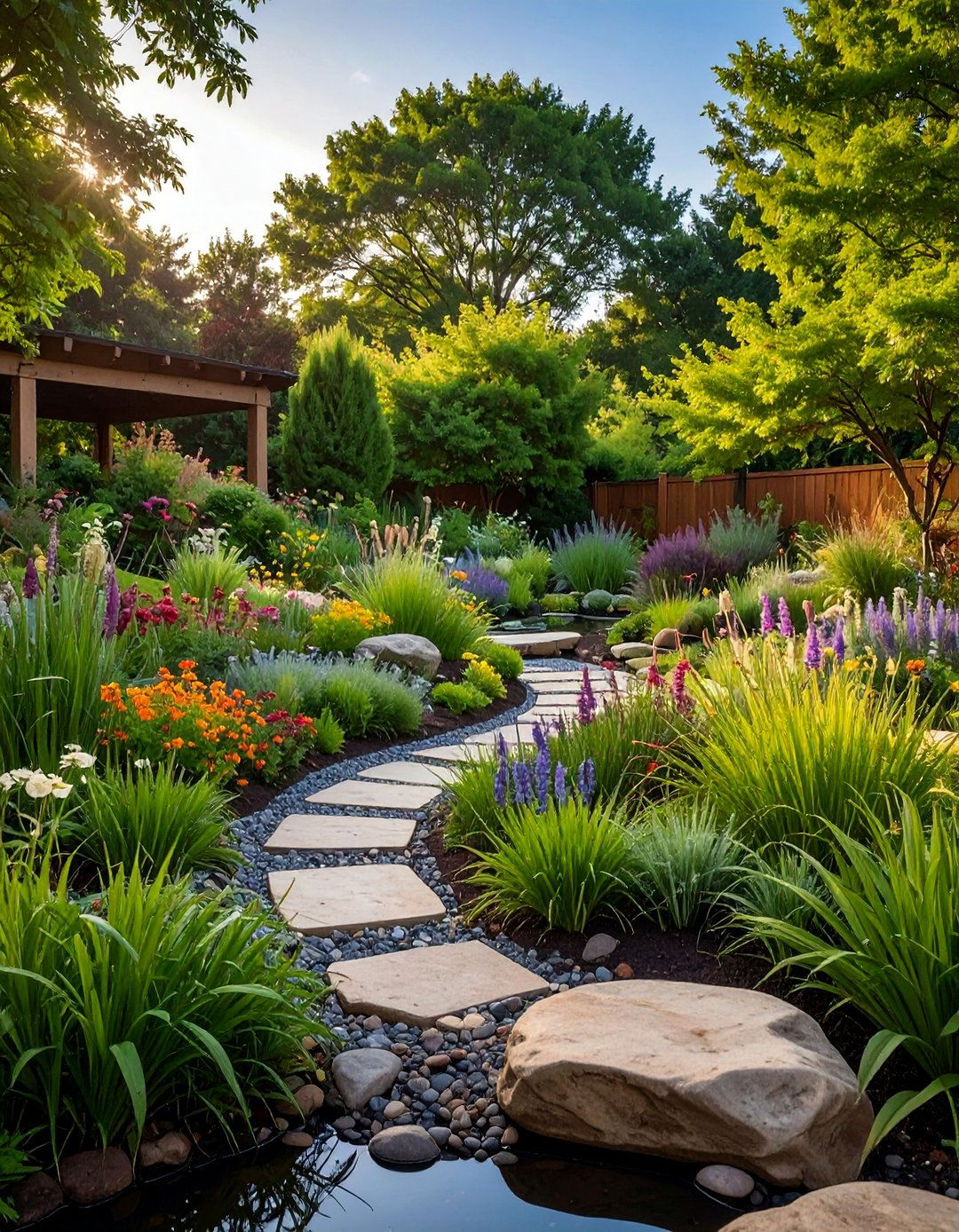

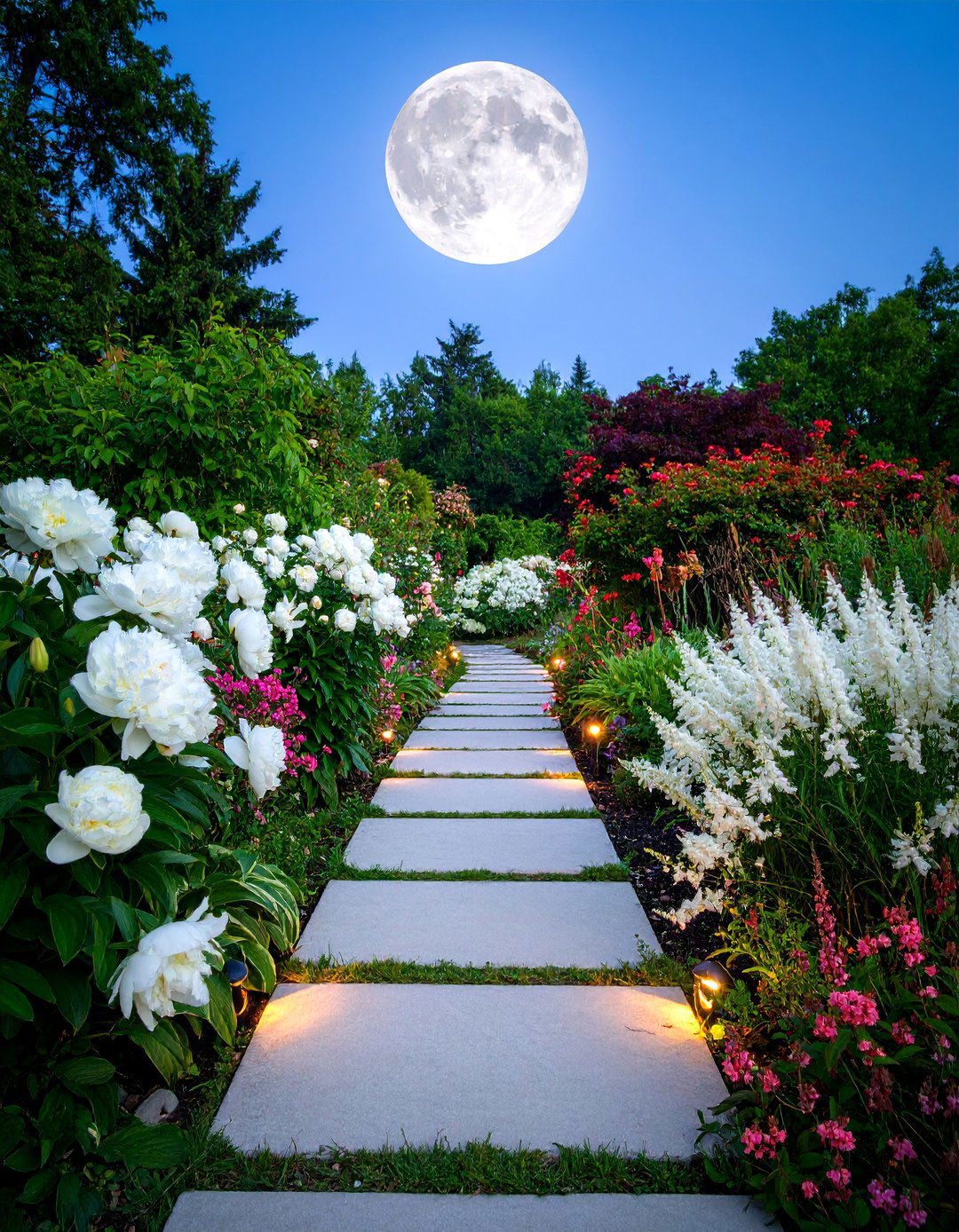
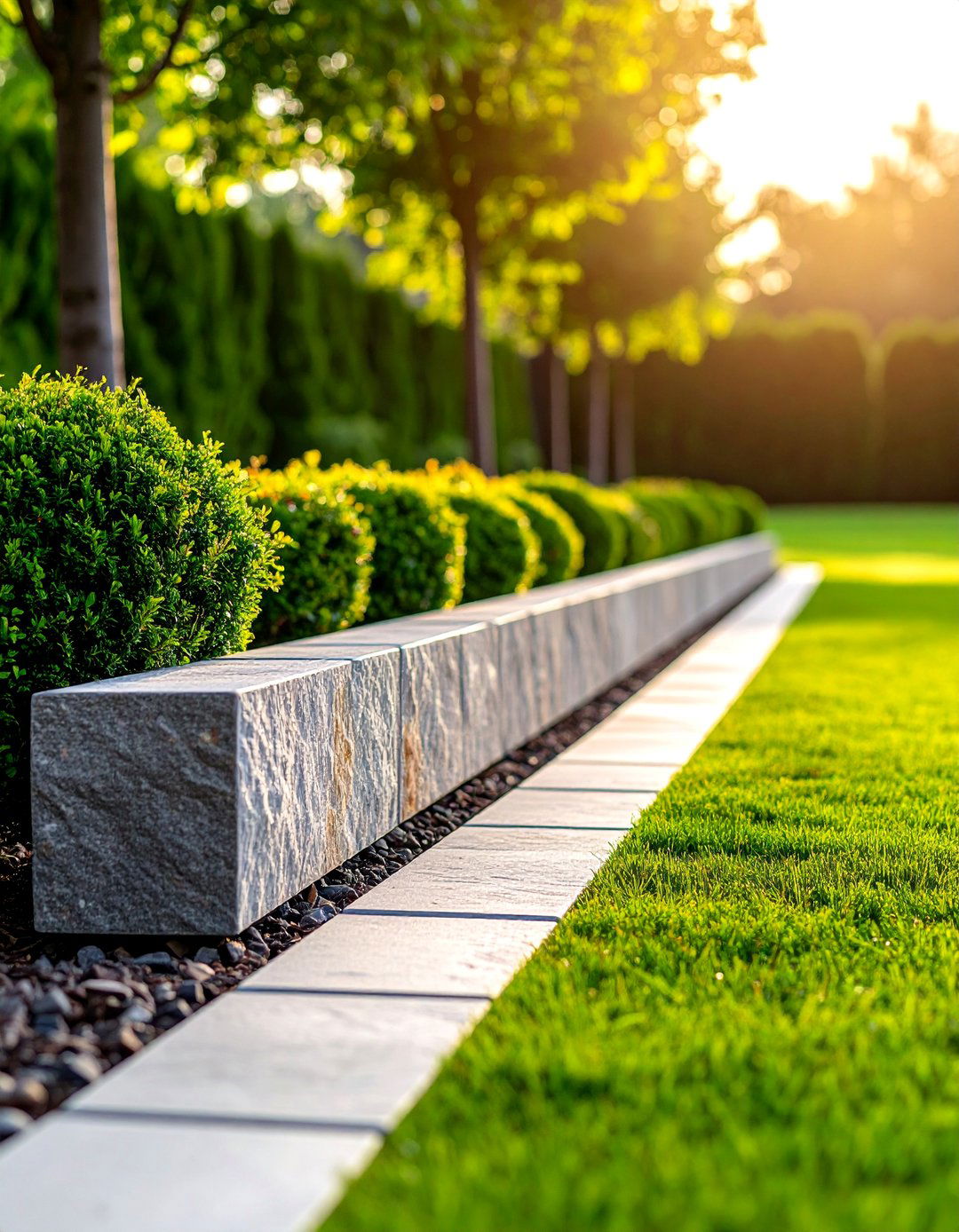
Leave a Reply